The showpiece event of European football took place at the Wanda Metropolitano in Madrid on Saturday evening. For the first time since 2008, the Champions League Final was an all-English affair, pitting Tottenham against Liverpool. Having been defeated in last year’s final by Real Madrid, Liverpool were one of the pre-tournament favourites to reach the final again. Tottenham, on the other hand, were relatively unfancied before the tournament began. This was reflected by the pre-game odds for the match. Liverpool could be found as low as 19/10 favourites, whereas Tottenham were priced at 435/100 on the same site.
In the following tactical analysis, we will discuss the set-ups of both sides, whilst highlighting the tactical plans and trends across the 90 minutes.
Routes to the final
Each side had incredible and also improbable routes to the final. Following a poor start to the group stages, Tottenham found themselves on just one point from their first three games. Spurs managed to find a bit of form to eventually qualify from the group stage by virtue of having scored more away goals than Inter Milan. Tottenham qualified from the group stages with eight points, the joint lowest of the 16 sides to progress. In the Round of 16, Spurs comfortably dispatched with Borussia Dortmund to set up a meeting with Manchester City. A missed Sergio Agüero penalty and a second-half Son Heung-min goal gave the London side a narrow lead to take to the Etihad. The game in Manchester became a Champions League classic. Spurs held on to progress (thanks to a late Raheem Sterling winner being overturned by VAR) on away goals. In the Semi-Final they met fan-favourites Ajax which became yet another Champions League classic. Spurs lost 1-0 at home in the first leg before finding themselves 3-0 down on aggregate with 45 mins left to play in Amsterdam. Up step Lucas Moura who scored an incredible hattrick to send Tottenham into the final.
Liverpool themselves also had a tough time of it in the group stages. In an admittedly tough group featuring PSG and Napoli. A late Roberto Firmino winner against PSG gave Liverpool a perfect start to the group before three defeats in their next four to put their place in jeopardy. Liverpool found themselves needing a victory of Napoli on the final matchday on the group stage to stay in the competition and a stunning save from Alisson protected their European hopes in the closing stages as he saved a point-blank Arkadiusz Milik header at the death. In both the Round of 16 and the Quarter Finals, Liverpool eased past their opponents comfortably to set up a Semi Final meeting with Barcelona. A Lionel Messi masterclass gave the Catalans a seemingly unassailable 3-0 first-leg lead over Liverpool. But the Reds had different ideas at Anfield. Liverpool turned it around winning 4-0 on the night to book their ticket in Madrid.
The lineups
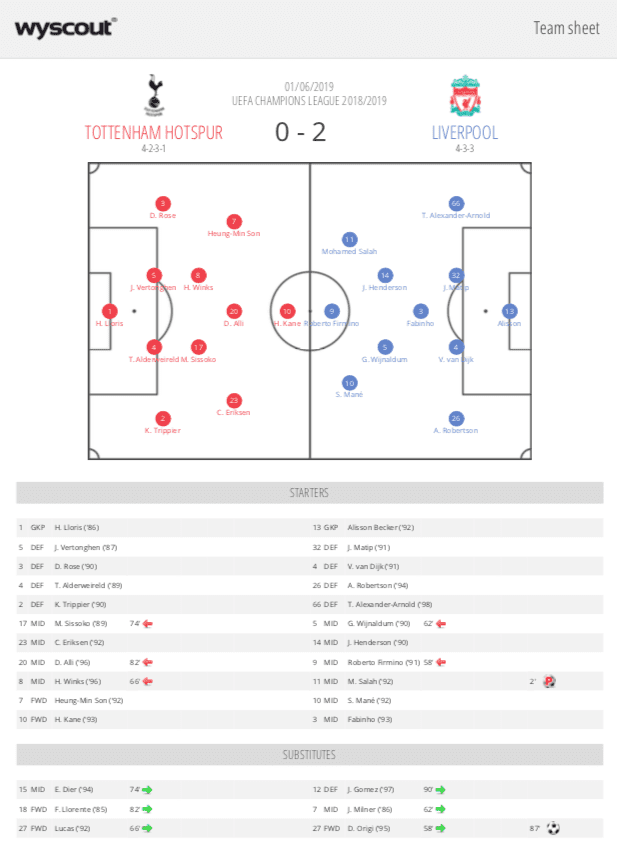
Liverpool’s team selection offered very little surprise. They lined-up in their usual 4-3-3 with the same back four which has featured in most of their games in the second half of the season. The midfield three consisted of Jordan Henderson, Fabinho and Georginio Wijnaldum. One of the heroes of the Semi-Final, Divock Origi, dropped out for Firmino who as always was flanked by Sadio Mané and Mohamed Salah.
Tottenham’s lineup did perhaps feature a few more surprises than their domestic rival. Mauricio Pochettino opted for a back four of Kieron Trippier, Toby Alderweireld, Jan Vertonghen and Danny Rose. The returning Harry Winks partnered Moussa Sissoko at the base of midfield. Ahead of them were Christian Eriksen, Dele Alli and Son. Harry Kane recovered in time to take his place in the starting 11 which perhaps controversially meant that Lucas Moura, the man who scored a hattrick in the Semi-Final to beat Ajax dropped to the bench.
The final starts with a bang
Immediately from kick-off, there was drama in the Champions League Final. In what is a fairly common strategy from most sides, Liverpool took the kick-off by laying the ball all the back from the centre spot to Joël Matip, who aimed a long, raking diagonal ball towards Tottenham’s right-back area. As the ball travels, Mané and Firmino move into a position to challenge the England full-back.
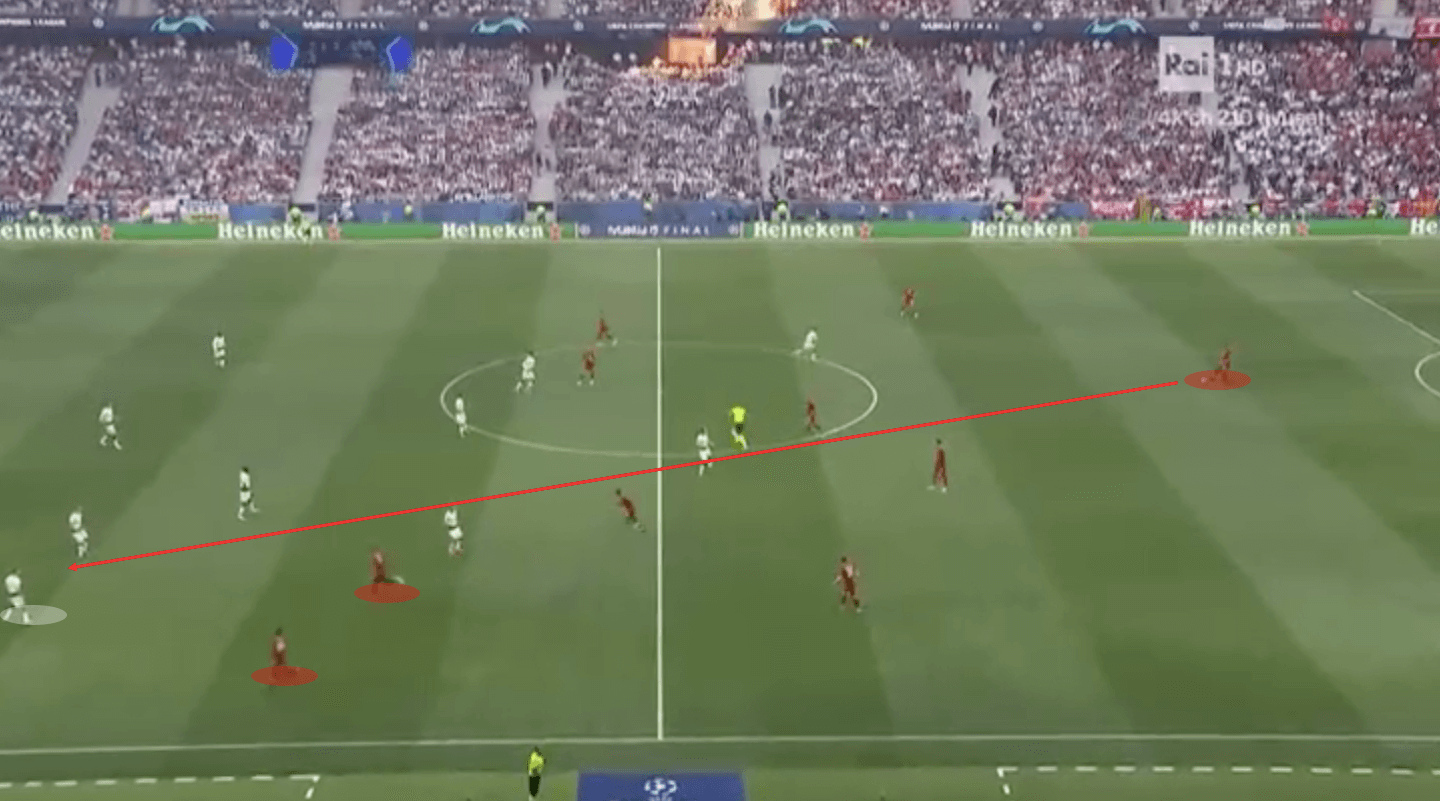
Liverpool clearly felt as though it would be easier to regain the second-ball from a loose defensive header from a Tottenham defender than it would be to try and play through the entire Spurs team, this became a feature of Liverpool’s game.
Trippier wins the header, unchallenged and in hindsight would probably wish he headed the ball out of play for a throw-in. His header is returned by Virgil van Dijk, with the ball eventually landing at the feet of Jordan Henderson.
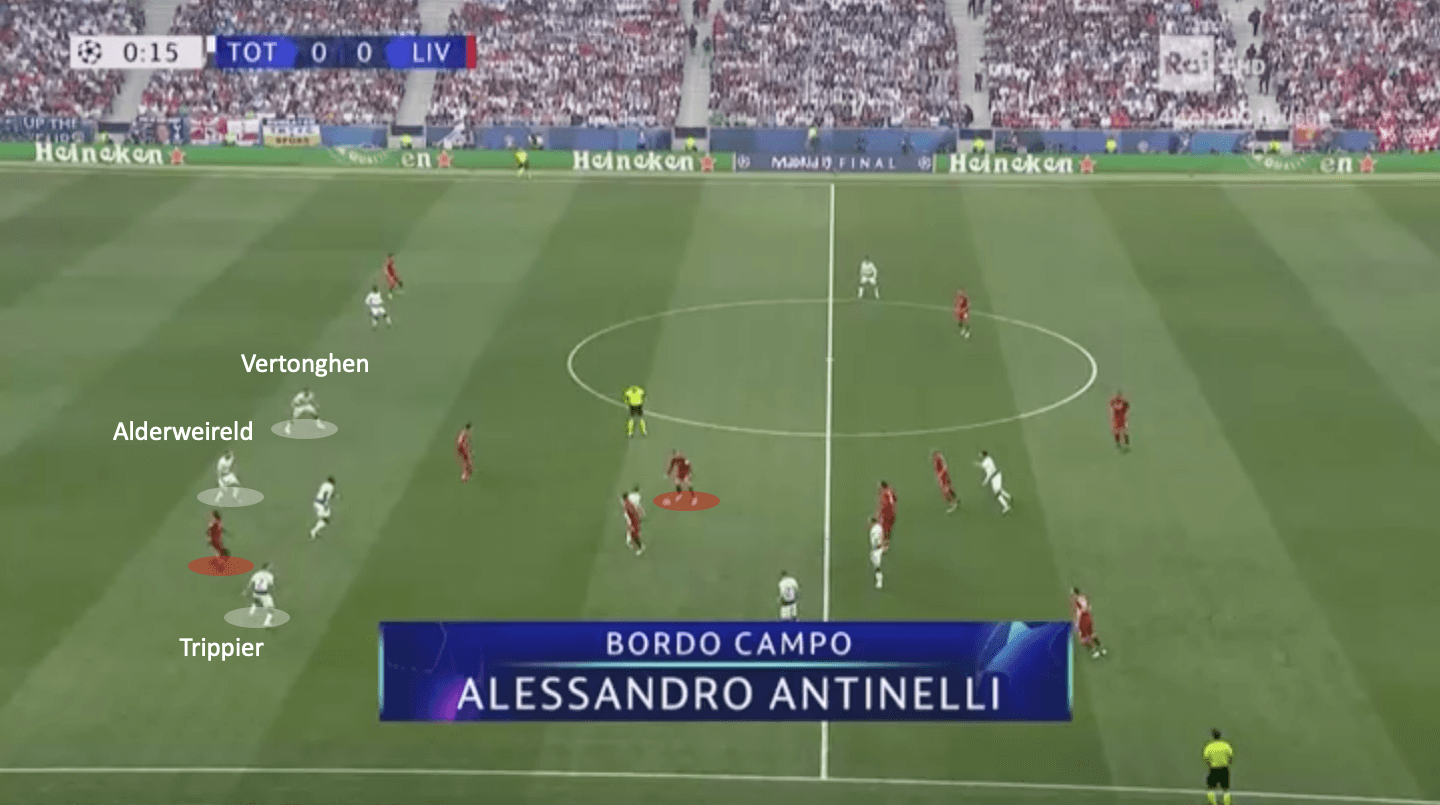
Given the frantic nature of the start of the match, Tottenham’s defensive line is in a less than ideal shape. Kieron Trippier finds himself the wrong side of Mané who has picked up a dangerous position between the centre-back and full-back. Both Alderweireld and Vertonghen appear to be flat-footed and are solely fixated on the ball rather than the potential run of Mané in behind. As the ball falls to Henderson he already senses the opportunity.
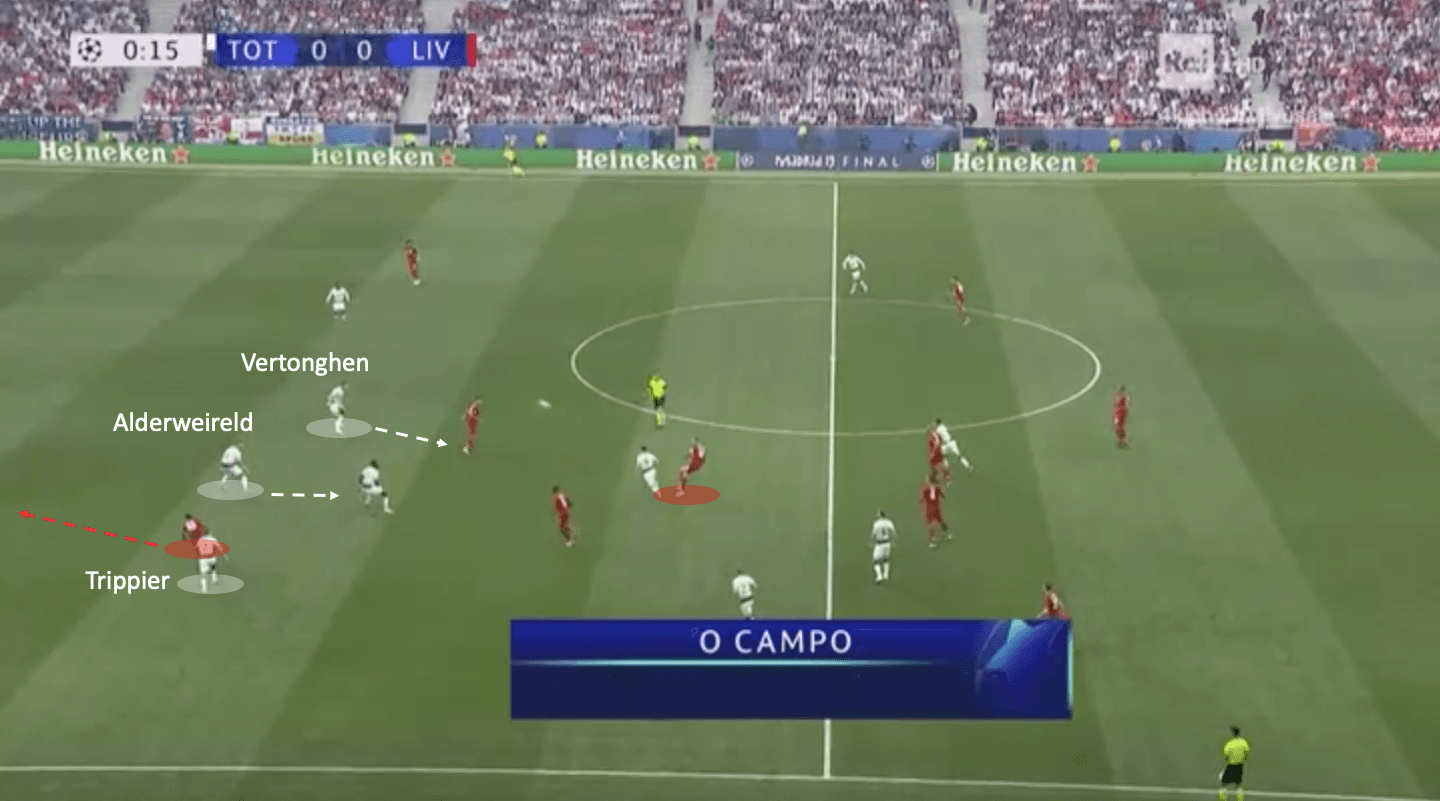
Without a second thought, Henderson lobs the ball over the high Tottenham defensive line. Mané has the jump on Trippier, whilst the two centre-backs appear more focused on the situation in front of them than behind. Mané collects the ball inside the Spurs box and in an attempt to reorganise the defence, Moussa Sissoko raises an arm to point instructions to his teammates and subsequently handling the ball.
With such a fast start to the game, it was difficult to get a full read on how both teams intended to play in this match. However, once the game settled down the patterns and styles of play became more clear.
Tottenham’s build-up play and Liverpool setting traps
Initially, Tottenham looked for a slow and patient build-up, progressing the ball from the goalkeeper, into the defenders before being played on the ground into the attacking players. Spurs operated with a double-pivot of Winks and Sissoko who would both come short for goal-kicks.
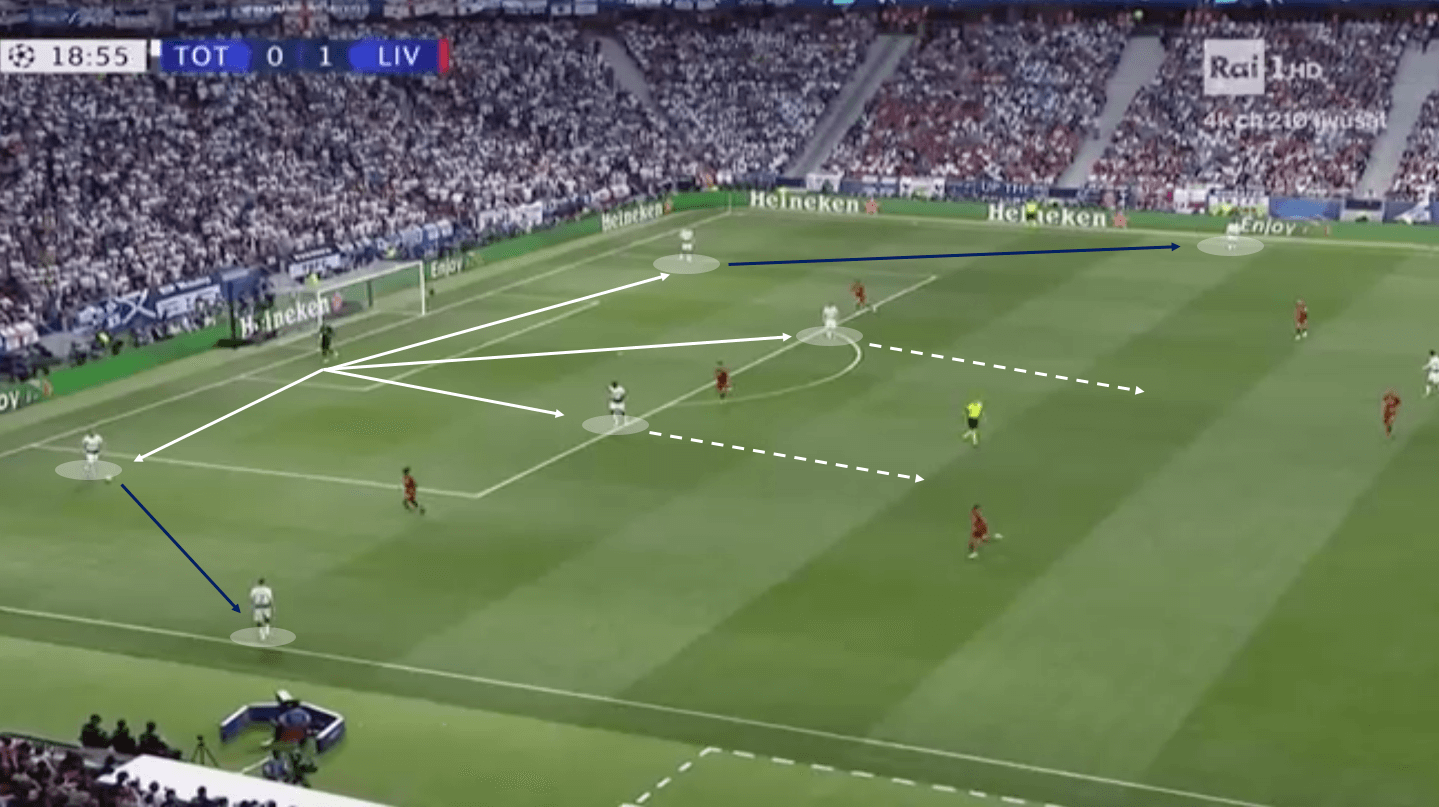
When Hugo Lloris had the ball, the centre-backs would split and Trippier and Rose would move high and wide. Sissoko and Winks would drop either side of Firmino and look to receive the ball and turn into the space between Liverpool’s front three and midfield three. Sissoko was perhaps more adept at this given his ability to run with the ball whereas Winks’ game revolves more around his intelligent ball movement.
When the ball got to the feet of Vertonghen or Alderweireld they would usually be presented with two options. Either, play the ball to the feet of Sissoko or Winks or look for a ball down the line to Trippier or Rose. Liverpool had their preferred route.

As noted in our preview of this game, Liverpool’s press involves funnelling the opposition into the centre of the pitch where they are more vulnerable for a turnover. In order to do this, the pressing runs of Mané and Salah are pivotal. The two wide-men would position themselves between the centre-back and full-back to prevent a simple pass down the line. In the image above we can see that both Winks and Sissoko are surrounded by Liverpool players. Should the ball be played into either of the two midfielders they would immediately be swarmed by all angles. Henderson and Wijnaldum are in close proximity to press from the blindside which is where a lot of Liverpool’s pressure regains occur. The gave Tottenham an early headache. They wanted to involve Sissoko and Winks in the build-up but didn’t want to take too many risks in possession. However, Rose and particularly Trippier who are vital in their ball progression were also unable to be picked out easily. This lead to Tottenham playing a number of long-balls in the first half as they weren’t willing to take the risk of being turned over in their own half as that is when Liverpool are at there most deadly.
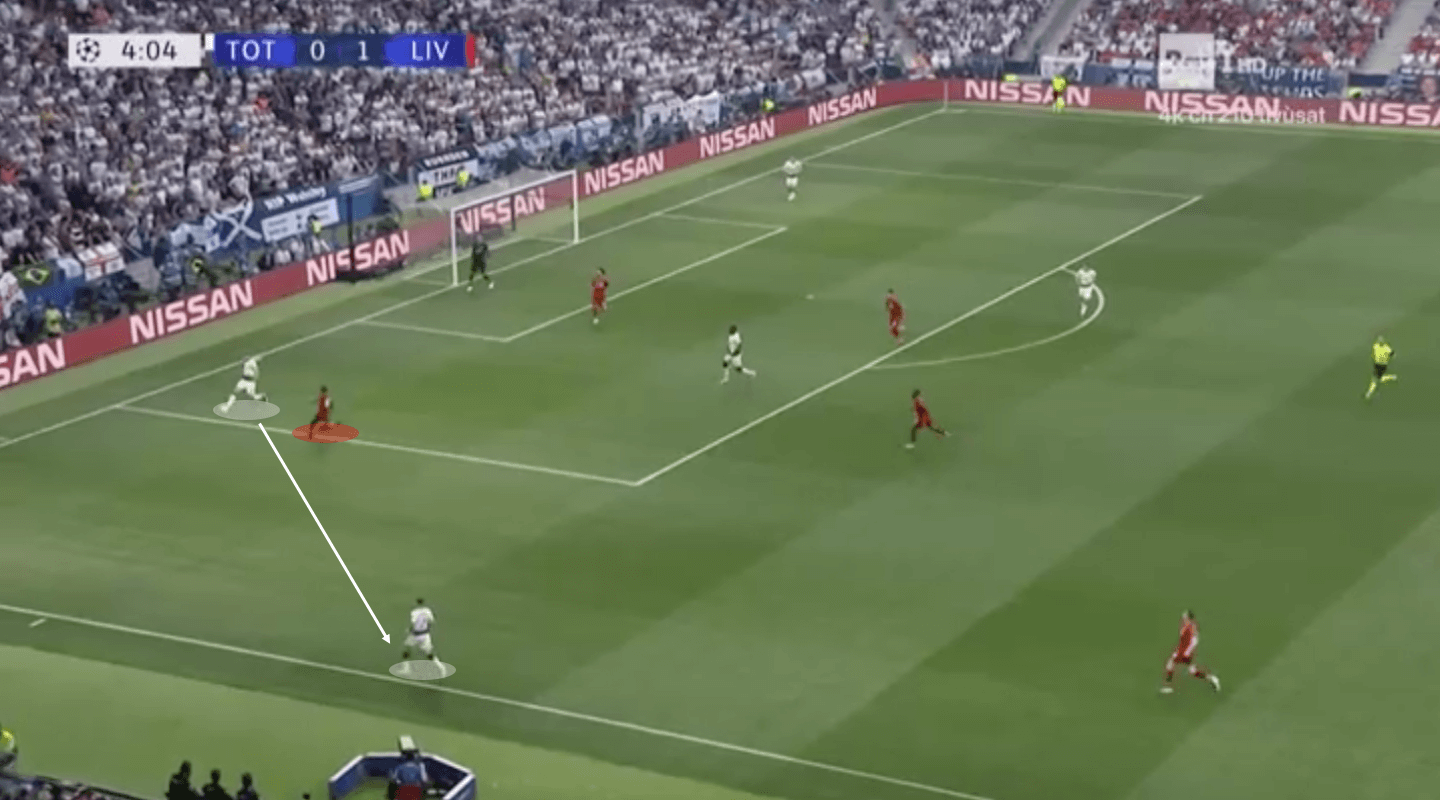
Tottenham were 1-0 down, however, and needed to be brave on the ball. When they were brave in possession they were able to play through Liverpool’s first line of pressure and found themselves getting into dangerous positions. Given the nature of Liverpool’s pressing, at times Tottenham used Sissoko as a decoy the attract Wijnaldum high up the field. By shifting the ball quickly between Alderweireld and Vertonghen they were able to open up an angle for the ball to be played into Kieron Trippier.
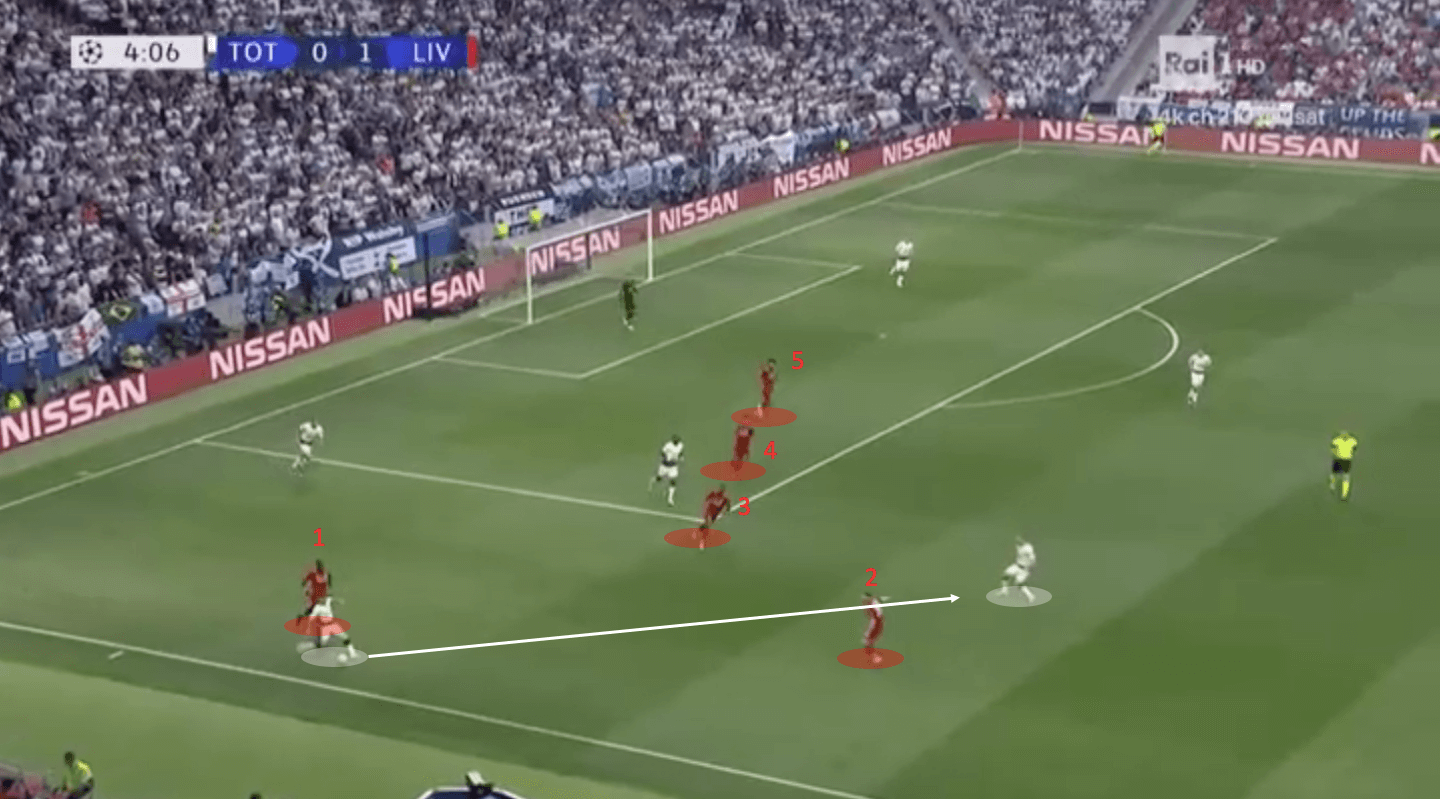
Kieron Trippier is a very capable passer of the ball in these scenarios and often makes the correct decision. From this position, Christian Eriksen has dropped inside of Andy Robertson into the space vacated by Sissoko and Wijanldum. Trippier drills the ball into Eriksen’s feet which eliminates five Liverpool players.
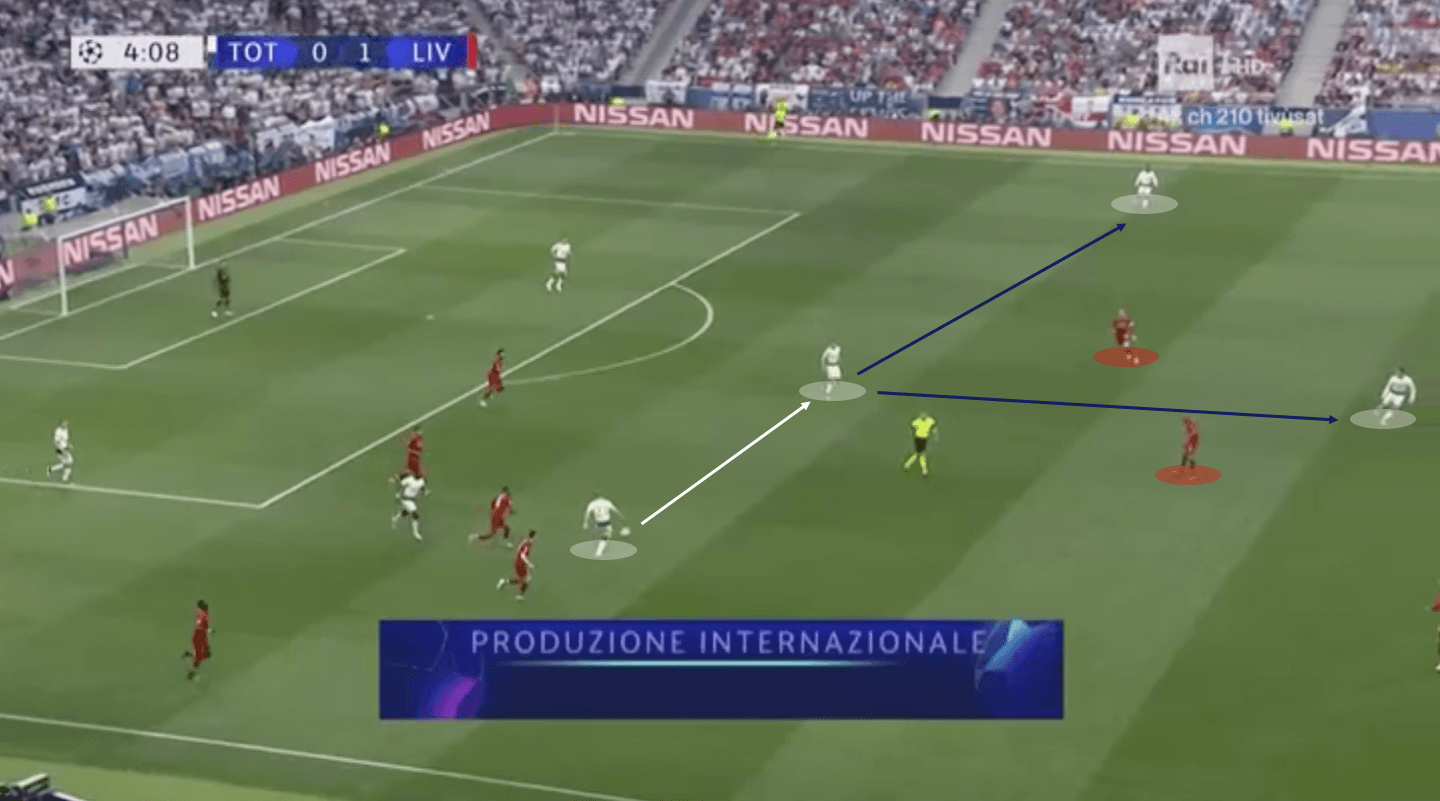
Eriksen is able to turn and play the ball into Winks, opening up the rest of the pitch. When the ball reaches Winks he has two options if he is able to trap the ball and release it quickly. He could play the ball into Alli, bypassing Fabinho and Henderson or he could play it wide for Rose to attack the space left by Henderson and Salah. However, Henderson makes a decisive move towards Winks that unsettles the Tottenham midfielder who decides to play the ball back to Vertonghen. Although the immediate danger was averted here, the potential for Tottenham was clear.
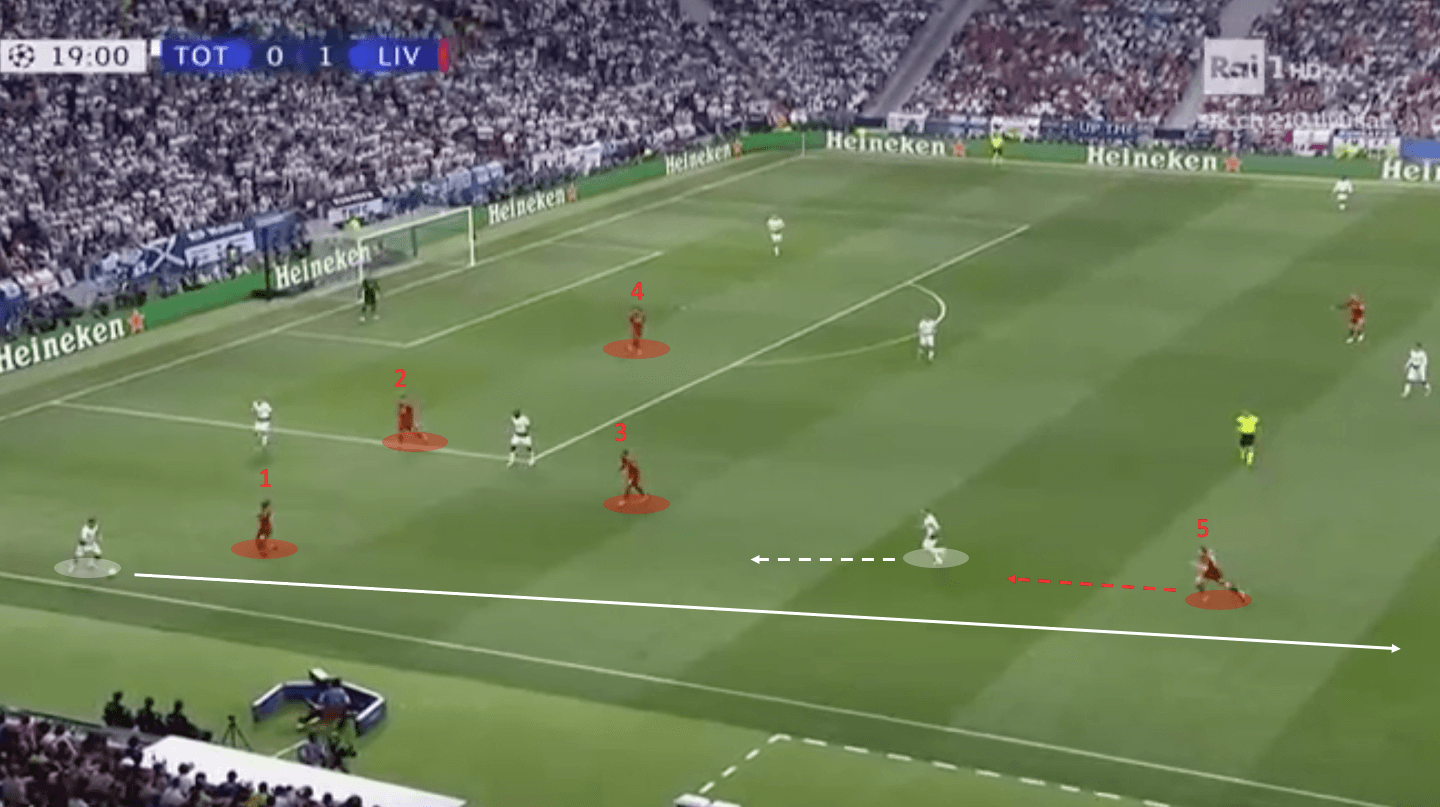
Another almost identical situation has developed above. Tottenham have worked the ball into Trippier in the right-back position. They have attracted in four Liverpool attackers, using Sissoko as a decoy. Eriksen is coming towards the ball to receive a pass to feet which in-turn attracts Robertson forward.
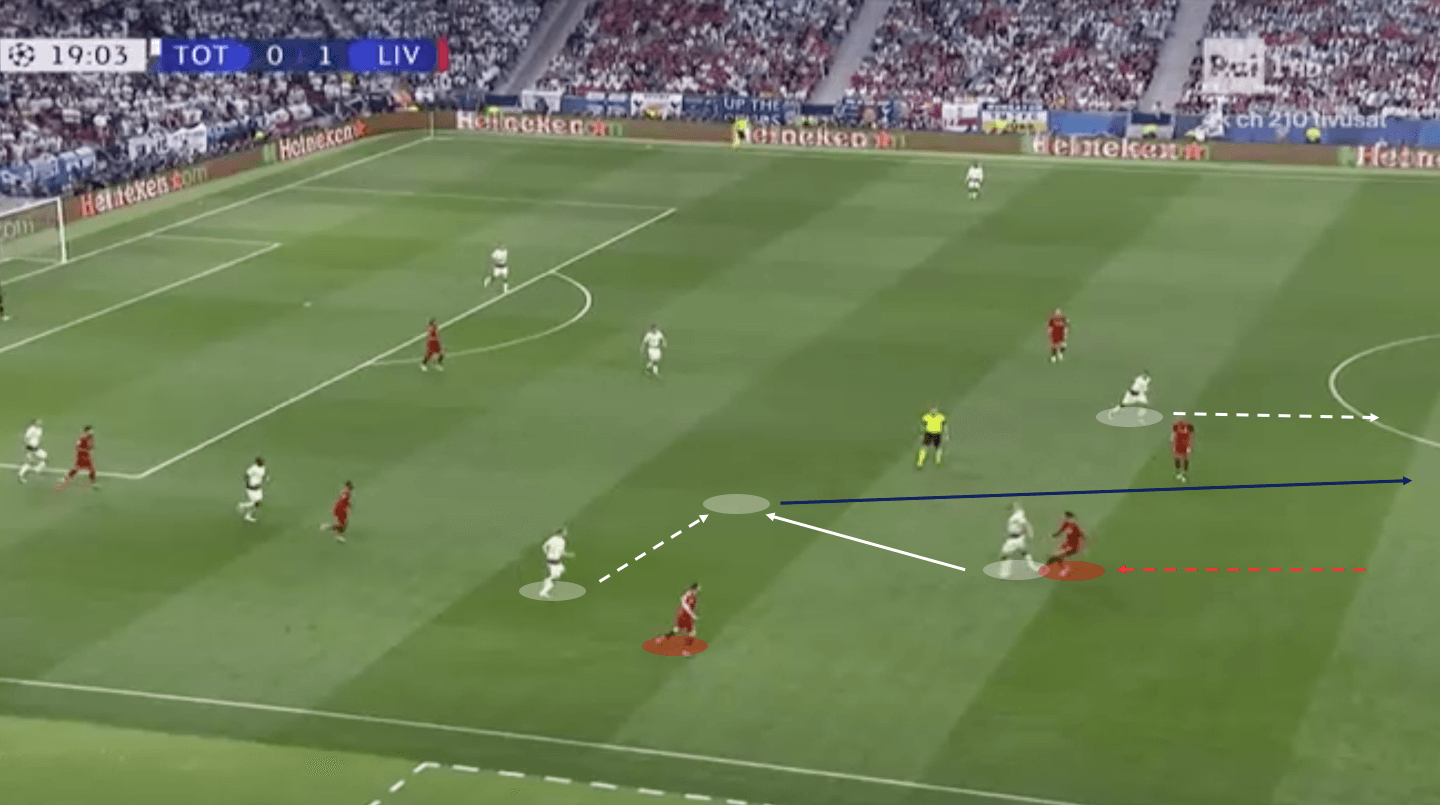
Trippier chips the ball over Eriksen and Robertson into the feet of Kane. As Kane has dropped deep and Liverpool have a number of players committed high up the pitch, van Dijk has to come forward with Kane to prevent him from turning into space. Kane drops the ball off to Eriksen. Dele Alli is making a run into the space that is vacated by van Dijk. Eriksen plays a pinpoint through ball into the path of Son who has cut inside from the left-wing.
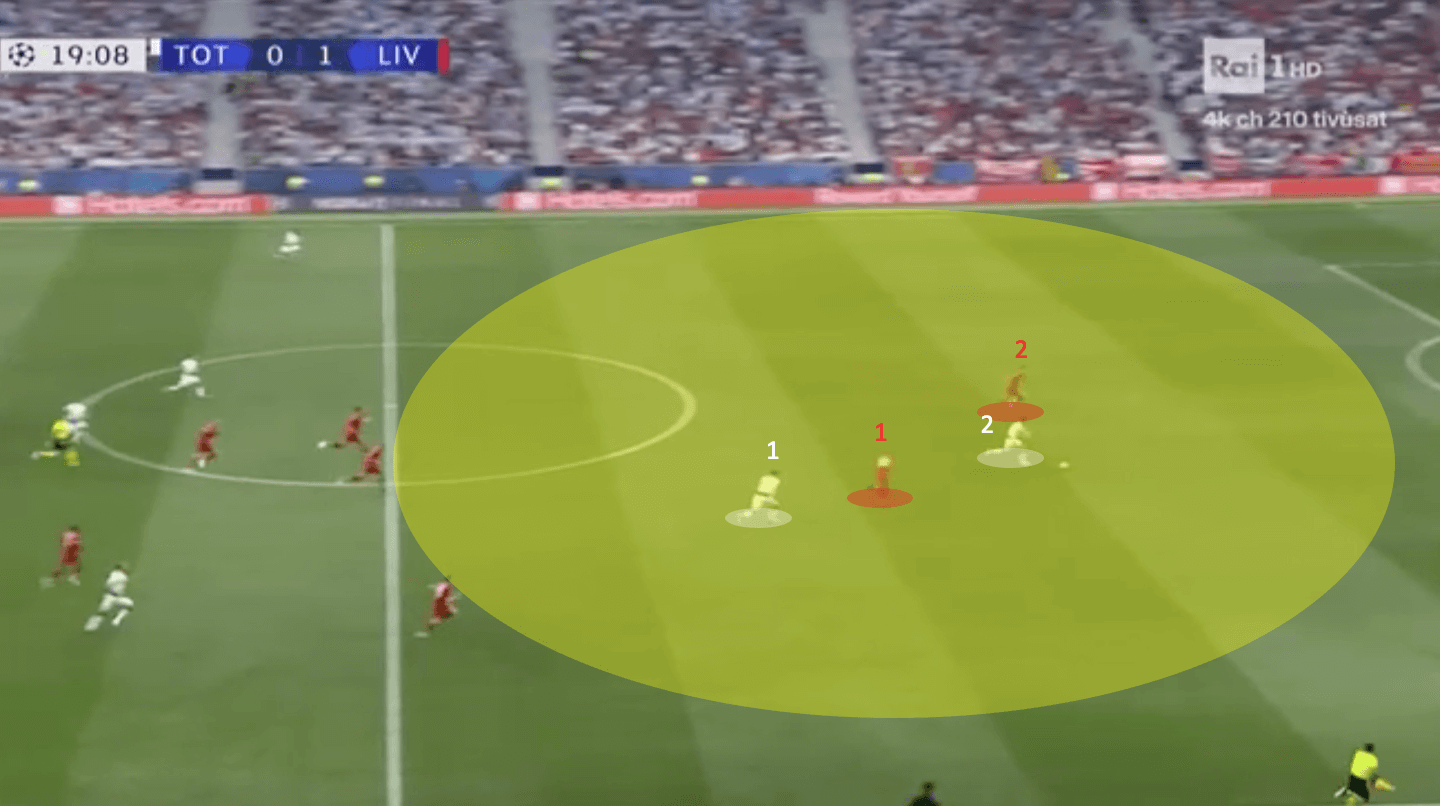
Son latches onto the through ball and Spurs have a 2v2 in a huge amount of space in the Liverpool half. This is the kind of situation that Son excelled in against Manchester City in the Quarter-Final but was unable to capitalise throughout this match.
Tottenham’s midfield box shape
Once Tottenham were able to progress the ball a little further into the middle third and final third of the pitch they arranged their midfield in a box shape.
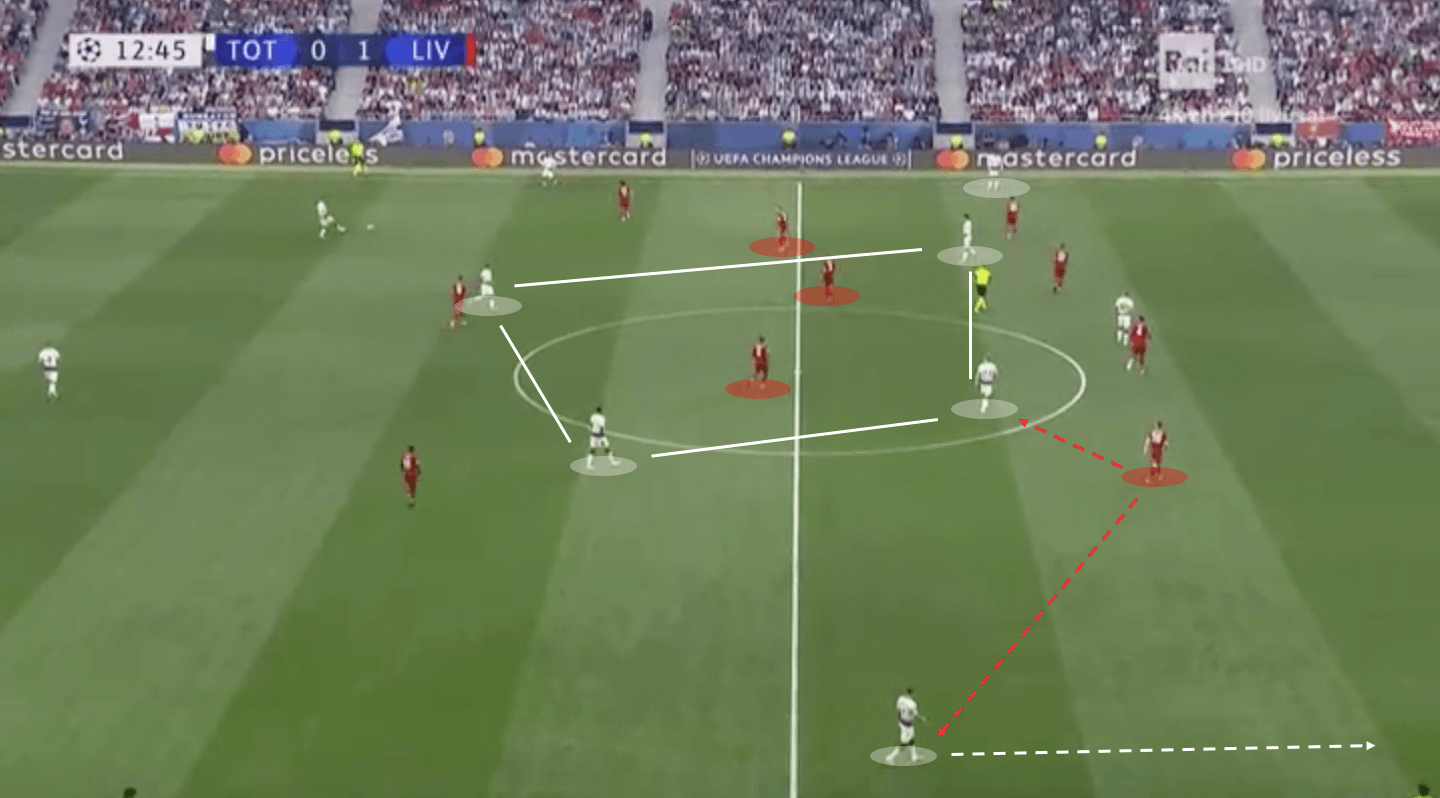
Sissoko and Winks are playing as a double pivot with Eriksen and Alli picking up positions between the defensive and midfield lines of Liverpool. This shape gave Tottenham a 4v3 advantage in the midfield area. This also helped Tottenham to create better connections between their midfield and attacking players. On the left-hand side, Son stayed high and wide, forcing Alexander-Arnold into deciding whether to stay wide and track his runs or to press Alli in the half-space. A similar situation occurred on the right wing. Christian Eriksen was selected as the nominal right-winger but his position was often more what is shown in the image above. When he moved inside, Andy Robertson had the same predicament as Alexander-Arnold. Eriksen is one of Tottenham’s most creative players so he has to be pressured when he receives the ball in space. But on the other hand, Trippier is Tottenham’s best crosser so he can’t be left to cross the ball with time and space.
Despite Eriksen and Alli picking up dangerous positions, Tottenham at times had difficulty picking them out and capitalising. This was due to poor execution of the passes but also due to Liverpool’s narrow midfield three making it hard for them to be easily bypassed. Moussa Sissoko was perhaps the only Tottenham player who had some joy in this area. His passing range and dribbling were both a huge weapon in the Spurs’ midfield.
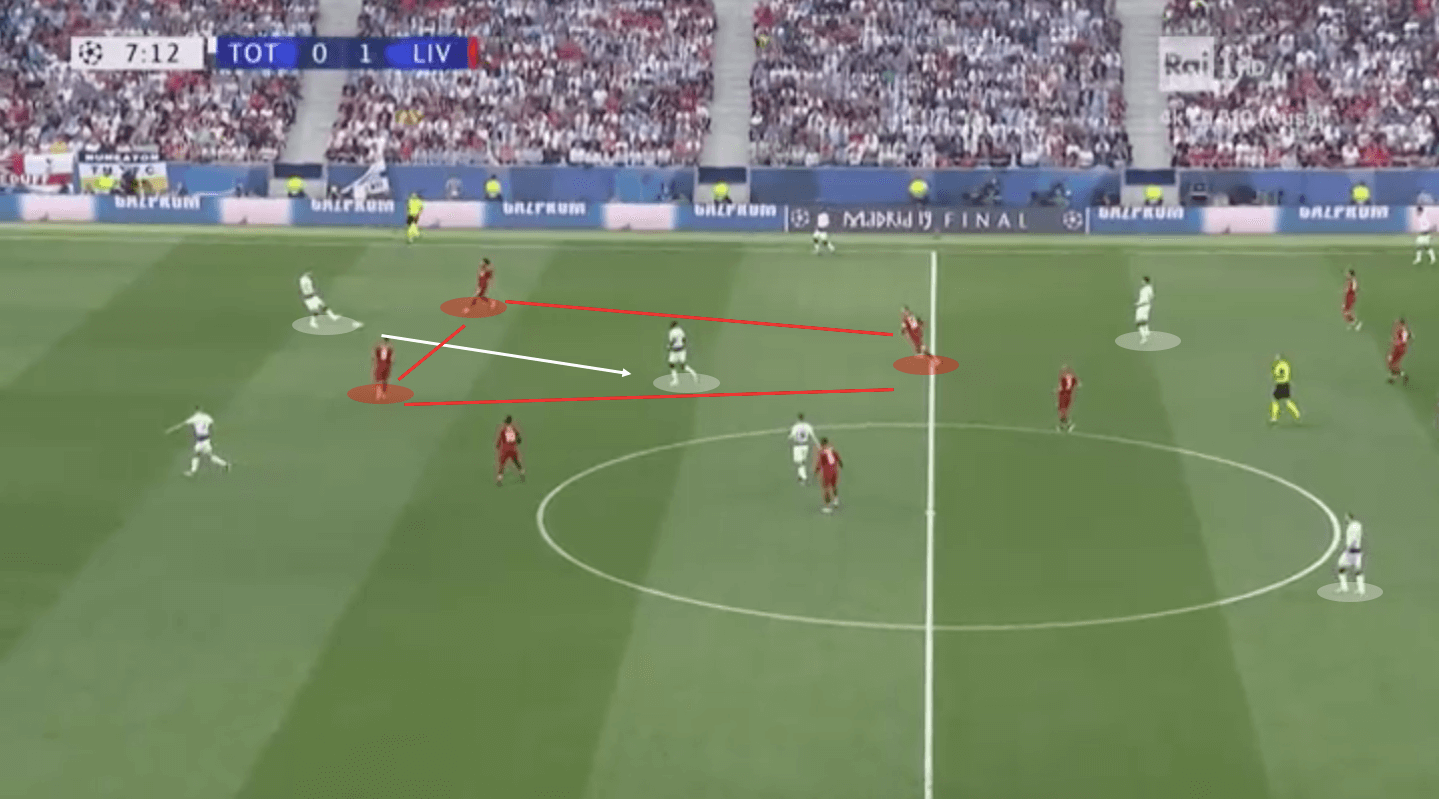
Despite finding himself in position for Liverpool to swarm him and win the ball back, Sissoko is found by Vertonghen. He is able to turn due to the high position of Rose but also a slight misjudgement from Henderson. Ahead of Sissoko, Alli and Eriksen are in dangerous positions in the half-spaces.
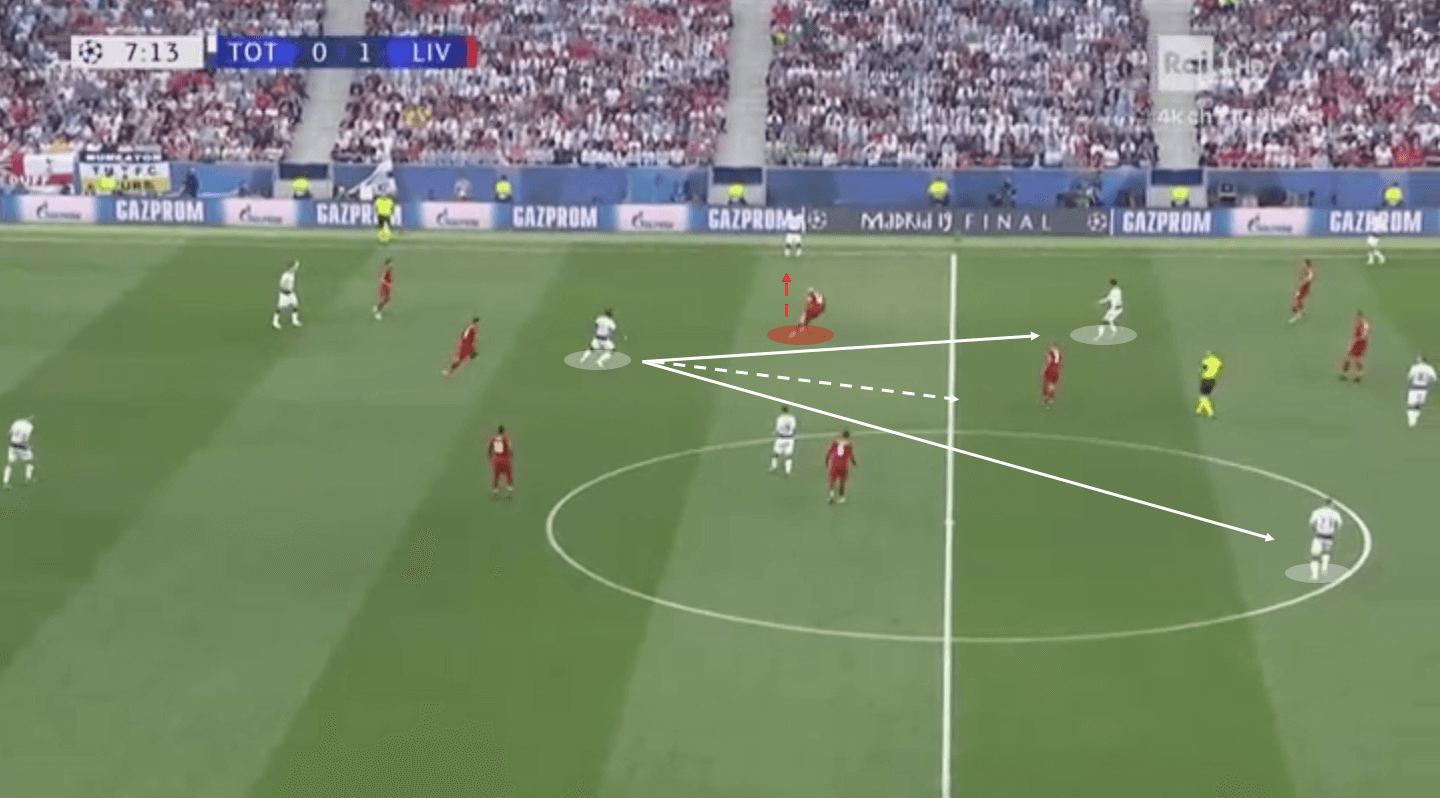
Henderson anticipates that Sissoko will knock the ball out wide to Rose. Instead, Sissoko turns and looks for either a ball into Eriksen or Alli, or he will dribble forward. He eventually plays the ball into Eriksen who rushes his ball through and gives the ball away. Sissoko found himself in situations like this a number of times but was often let down by poor decision making in the final third.
Another thing that made it difficult for Tottenham to create clear-cut chances was the 4-5-1 mid-block employed by Liverpool. In the image below we can see that Liverpool restricting the space available for the likes of Alli and Kane to operate but having a fairly low line of engagement but holding a relatively high line. Liverpool were fairly confident in this situation that they could stifle the Tottenham attacks as there was no huge threat in behind. Son is the only Spurs player who can really threaten in behind but also Liverpool have one of the world’s best ‘sweeper’ keepers in goal.
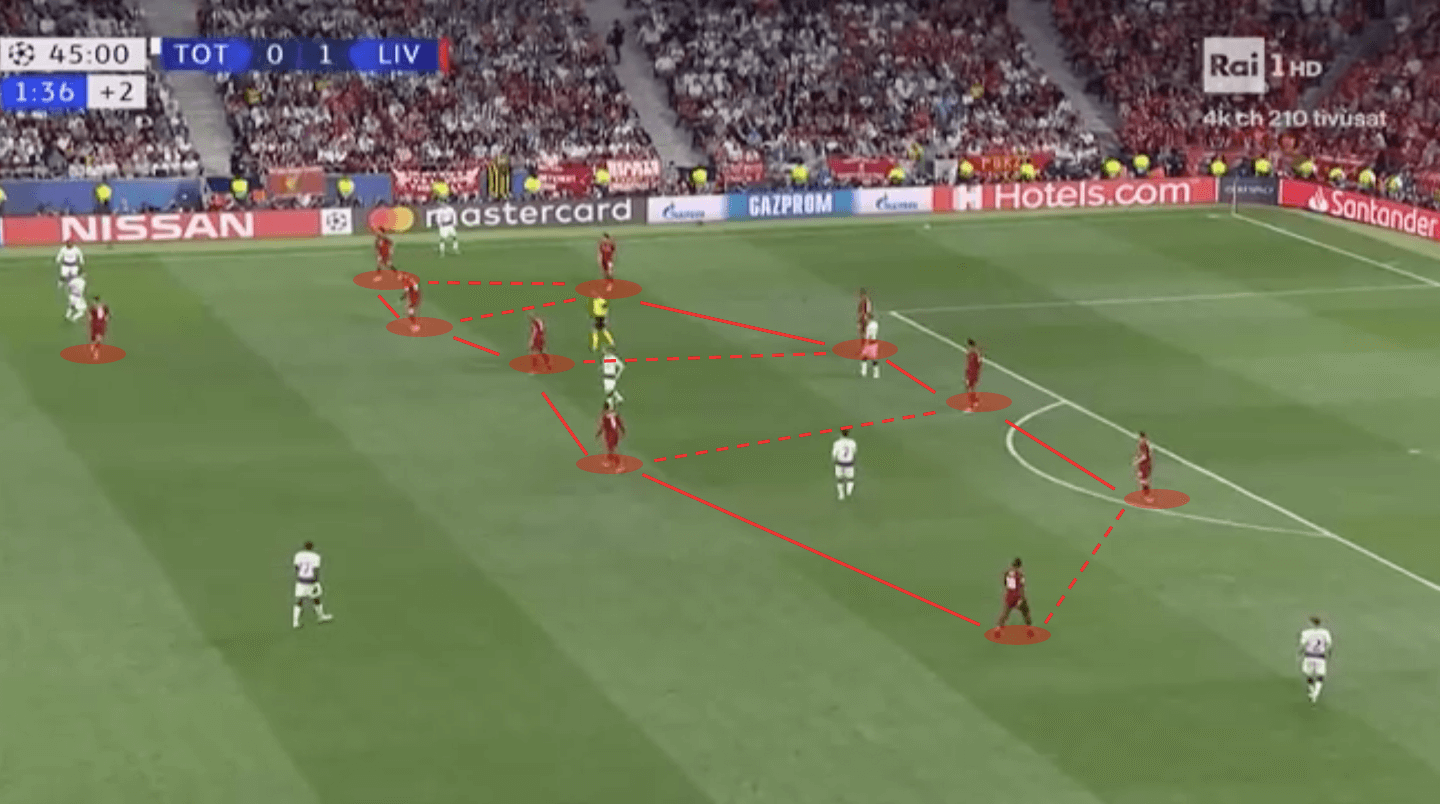
Tottenham’s change of attacking shape
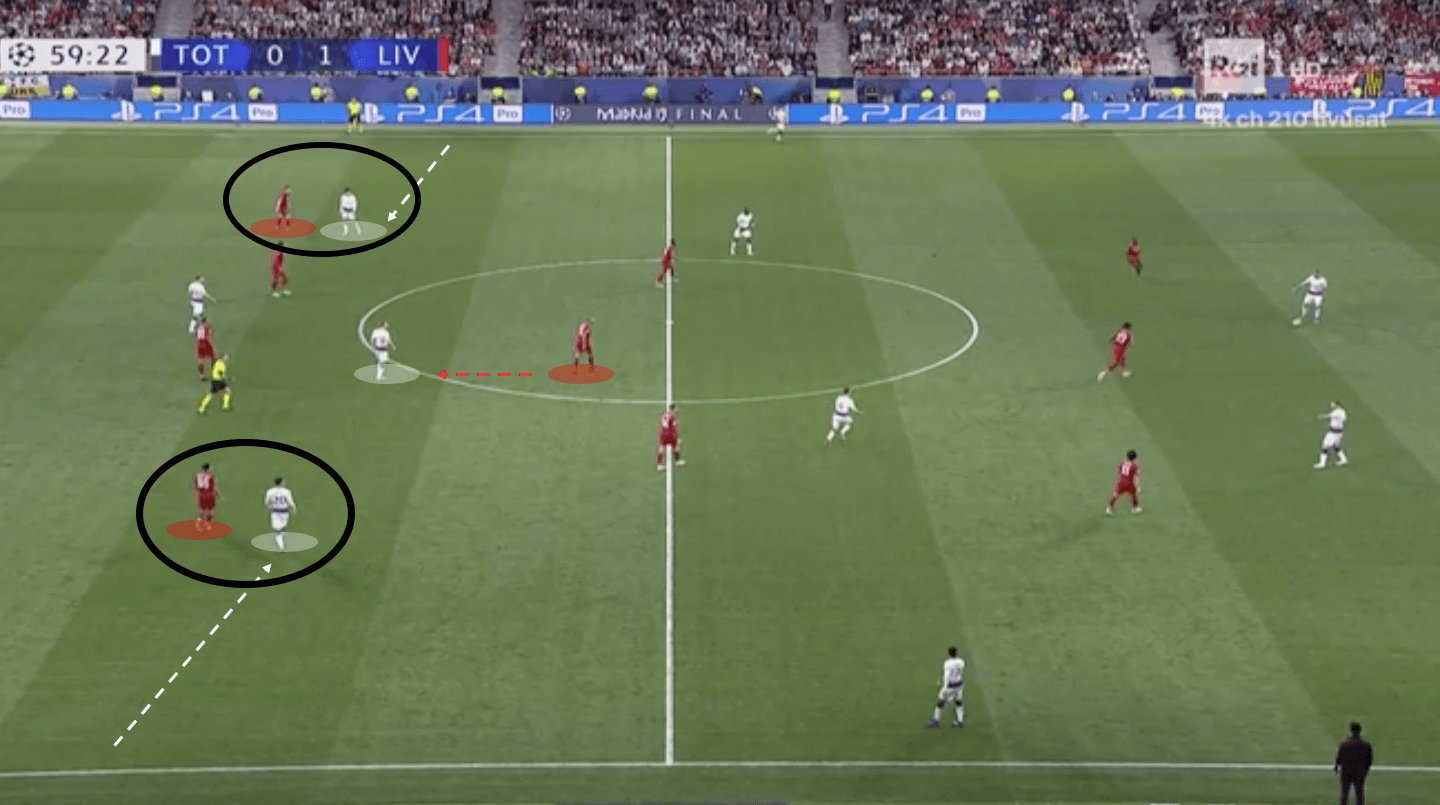
In the second half, Tottenham switched their attacking shape. Instead of attacking with two players in the half-spaces, they attacked with one player in between the lines with two attacker players either side of the ‘number 10′. This was much easier for Liverpool to defend. In the image above we can see that Eriksen is being in Fabinho’s cover shadow and any pass into him would be extremely risky and difficult to pull off. Both Alli and Son are slightly narrower than Tottenham’s wide players were in the first half. This made it far easier for Alexander-Arnold and Robertson to mark them as they only needed to worry about one opposition player. As we can see in the image above, both of Spurs’ men are tightly marked.
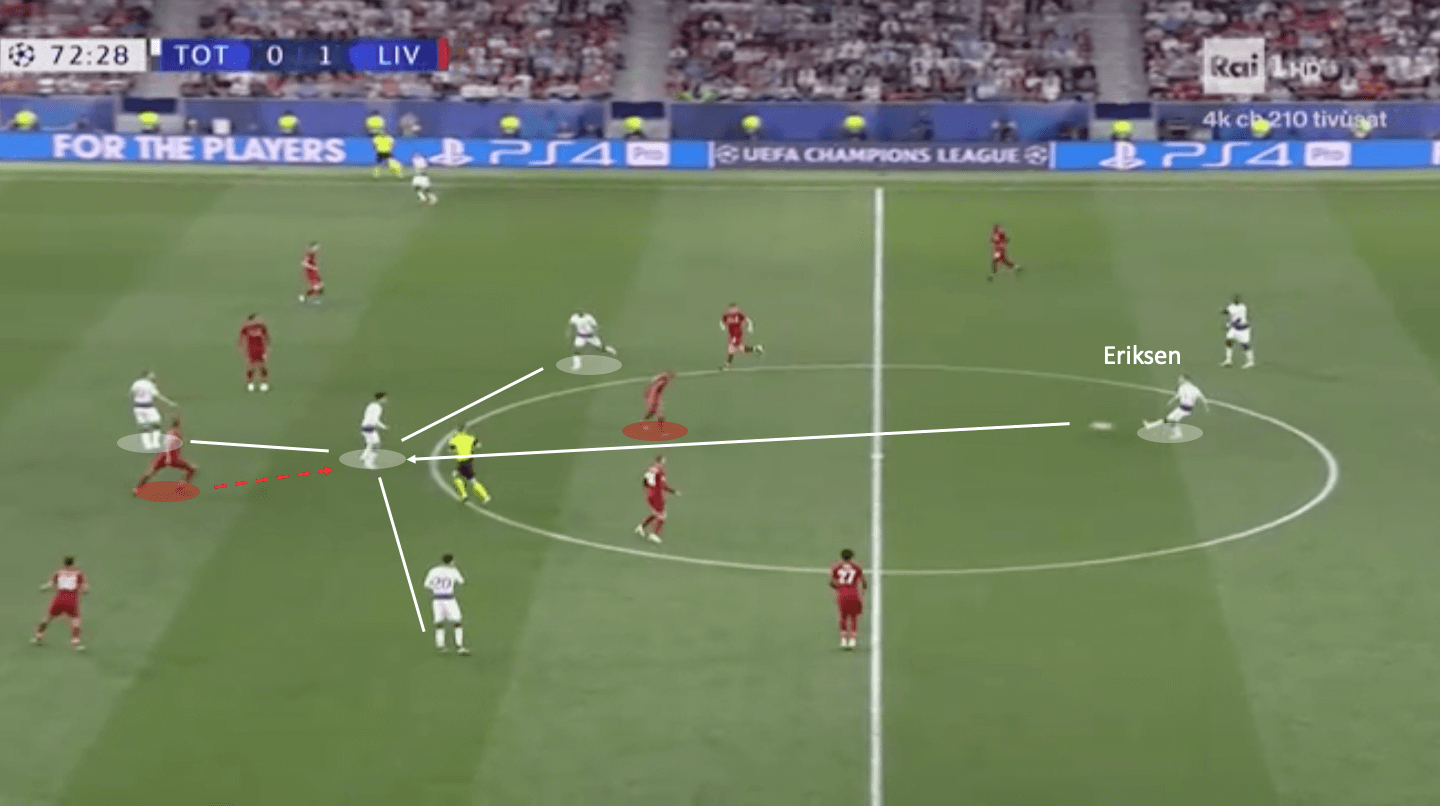
Tottenham were only able to create one opening of note with this attacking shape. This occurred when Eriksen dropped into a deeper role following the substitution of Harry Winks. In the deeper role, Eriksen had more time and space to pick line-breaking passes. Prior to this Eriksen had really struggled to impact the game in a positive way. In this image, his passing range is on full display. His pass finds the feet of Son who has Lucas, Alli and Kane all in close proximity to him. Son flicks the ball around the corner to Kane as Matip moves to close him.
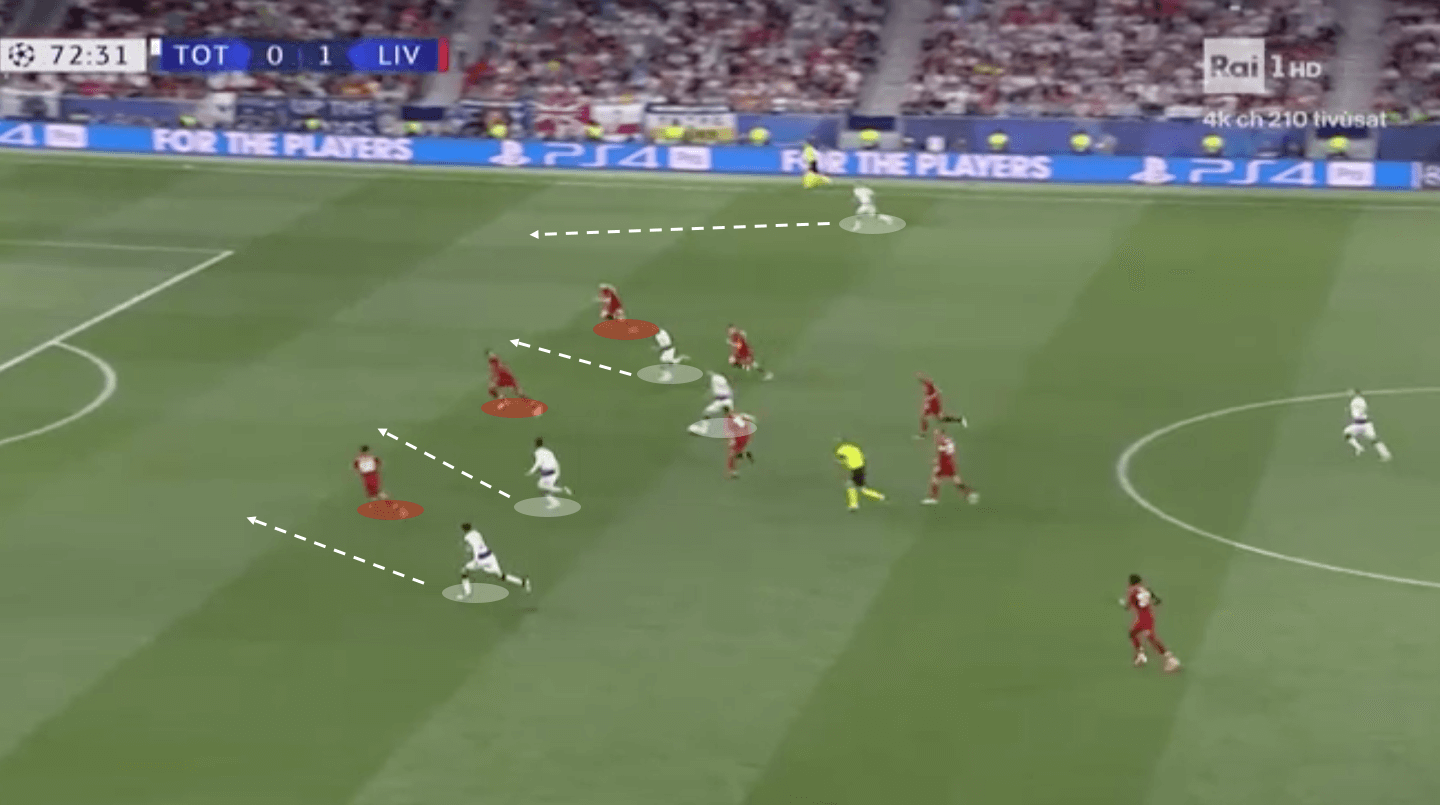
Once Kane controls the ball, Tottenham have a 4/5v3. Both Robertson and Alexander-Arnold have men making runs inside and outside of them. This was an incredibly promising opening for Spurs but yet again they were let down in the final third by poor execution and decision making.
Tottenham’s defensive set-up
Tottenham had a number of different defensive shapes. At times they held a 4-4-2 shape, a 4-3-3 shape and a 4-4-1-1/4-5-1 shape. Given the flexibility of Tottenham’s attacking players, in that, they can all operate in different positions across the pitch. This is beneficial as this meant if they were perhaps caught out of position it wouldn’t have too drastic of an effect on their defensive shape. In the image below we can see Kane and Eriksen forming the first line of defence with Alli and Son on the wings.
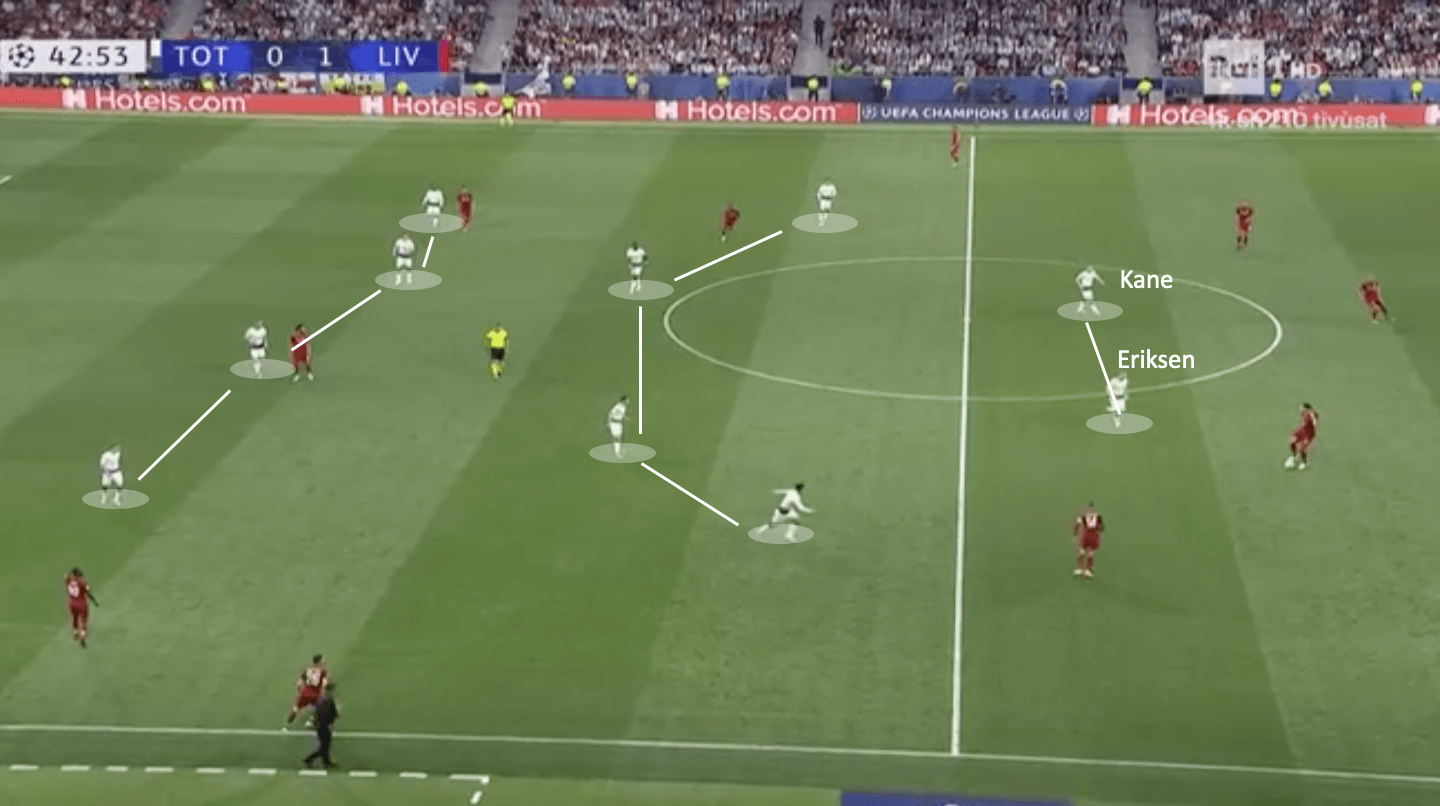
From goal-kicks, Tottenham would set-up in a 4-3-3. Kane would be through the middle, flanked by either Son and Alli or Son and Eriksen.
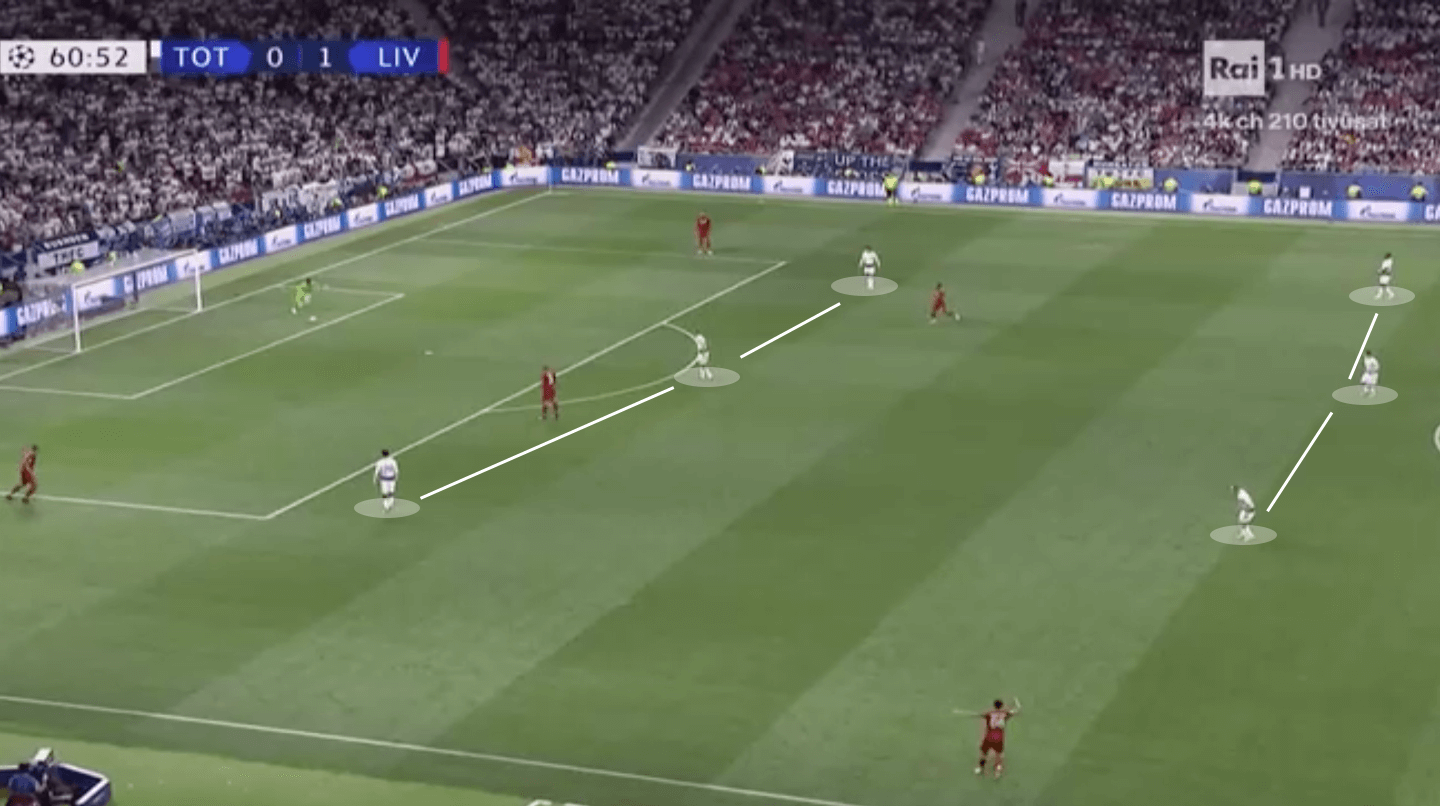
When Liverpool progressed the ball into Tottenham’s half, Spurs would drop back into a more rigid 4-5-1/4-4-1-1 shape with Erisken/Alli/Son defending just off Kane.
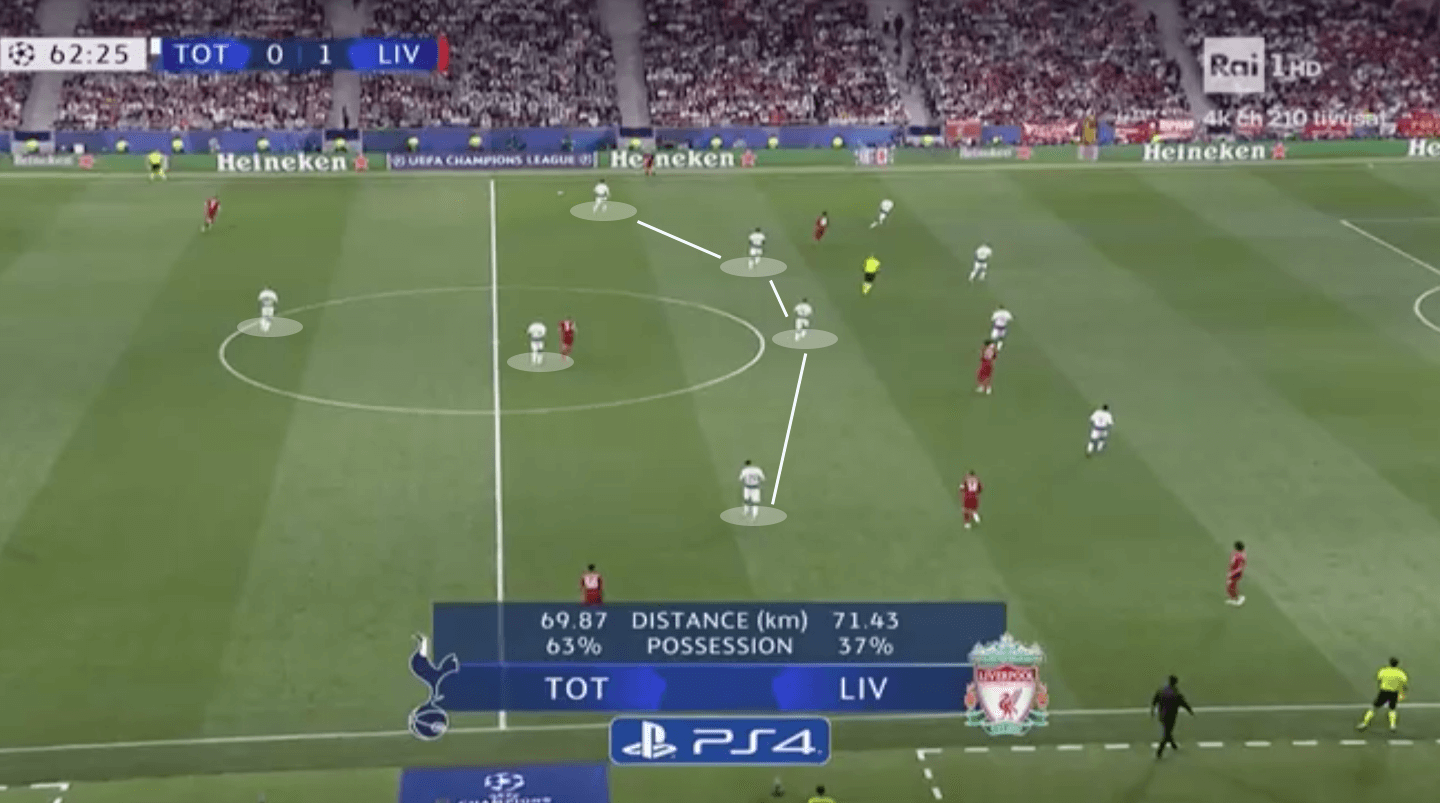
Liverpool’s build-up play
It is fair to say that this wasn’t a typical Liverpool display in terms of build-up. As highlighted in the opening passage of the game which led to the handball for the penalty, Liverpool were more focused on the ball being in Tottenham’s defensive third and looking to build from second balls. As a result, Liverpool played far more long direct balls, either into space or up to the front three. This is highlighted in the statistics. On average Liverpool play 5.73 passes per possession, in this game, it was down to 2.23. Their average pass length before the final was 19.94m, in the final, it was 22.75. They had a total pass accuracy of only 70% when their average across the season has been 85.7%. Across the entire match, Liverpool only completed 177 passes when they average 582 completed passes.
Liverpool’s different style of play in the final is further evidenced by looking at the individual passing stats of the players. Trent Alexander-Arnold completed just 11 passes at a rate of 46% accuracy. Across the season Alexander-Arnold completed 55 passes per game at a 76.3% accuracy. Every single player for Liverpool was way down on their average passing numbers.
This is an interesting change of approach from Klopp and ultimately proved successful. As noted at the beginning of the article Liverpool were able to create a goalscoring opportunity from the exact situation which they clearly played for all game.
That isn’t to say that Liverpool abandoned any semblance of their usual play. They still played short from goal-kicks, as shown below. The two centre-backs split with Wijnaldum and Fabinho dropping onto the edge of the box. Unlike when Tottenham had a goal kick, Liverpool were afforded quite a lot of space on the edge of the area should they chose to play through the middle of the pitch.
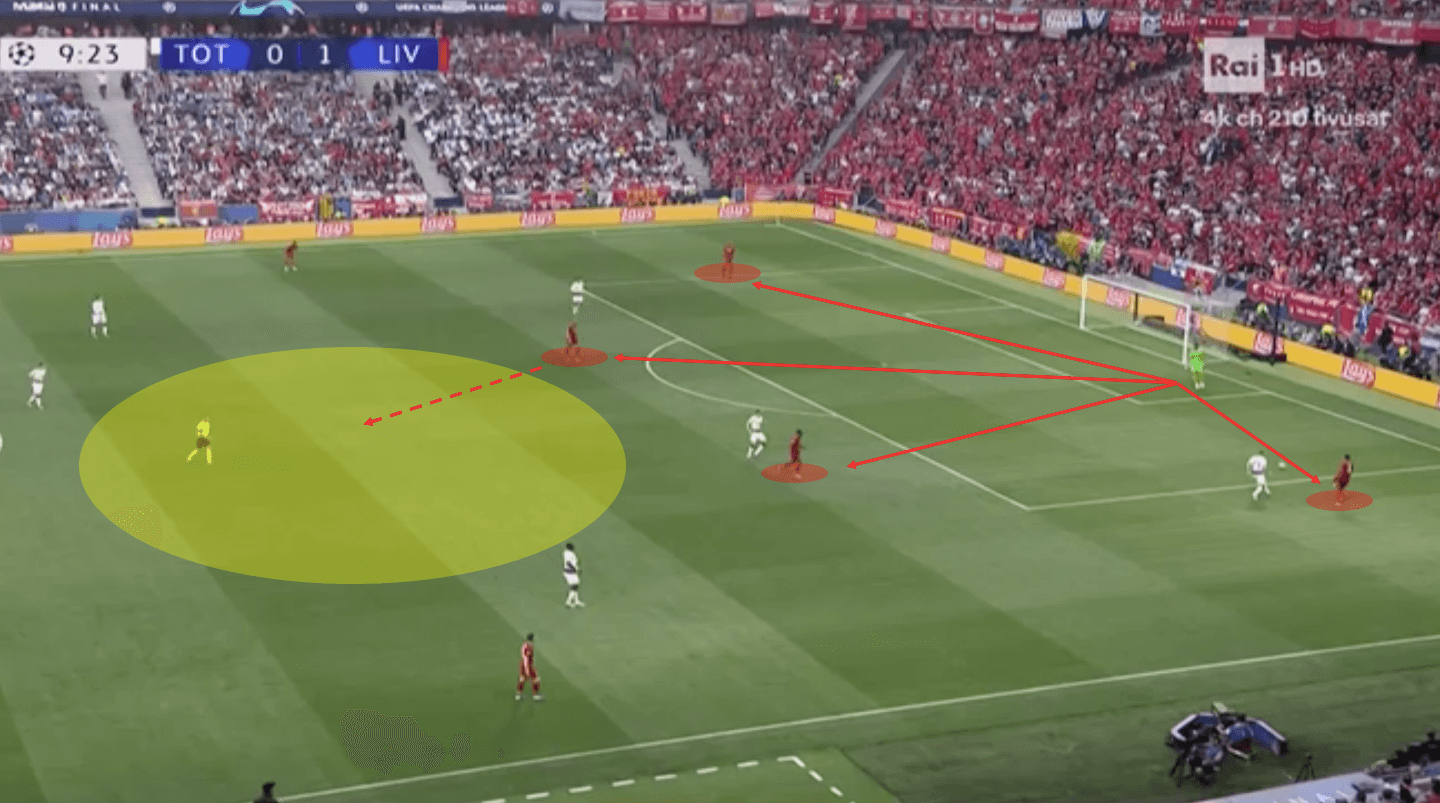
Liverpool were at times, able to take advantage of Tottenham’s man-oriented pressing system. In the image below, we can see that the Spurs’ players have all moved into a position to defend a member of the opposition. However, van Dijk has minimal pressure applied to him. With both Sissoko attracted upfield, Winks is left to defend the middle of the pitch alone. When Firmino drops deep and Henderson advances slightly, Winks is caught in a 2v1 in the centre of the pitch. In just a short number of passes, this attack eventually reaches the edge of Tottenham’s box and Mo Salah puts a shot wide.
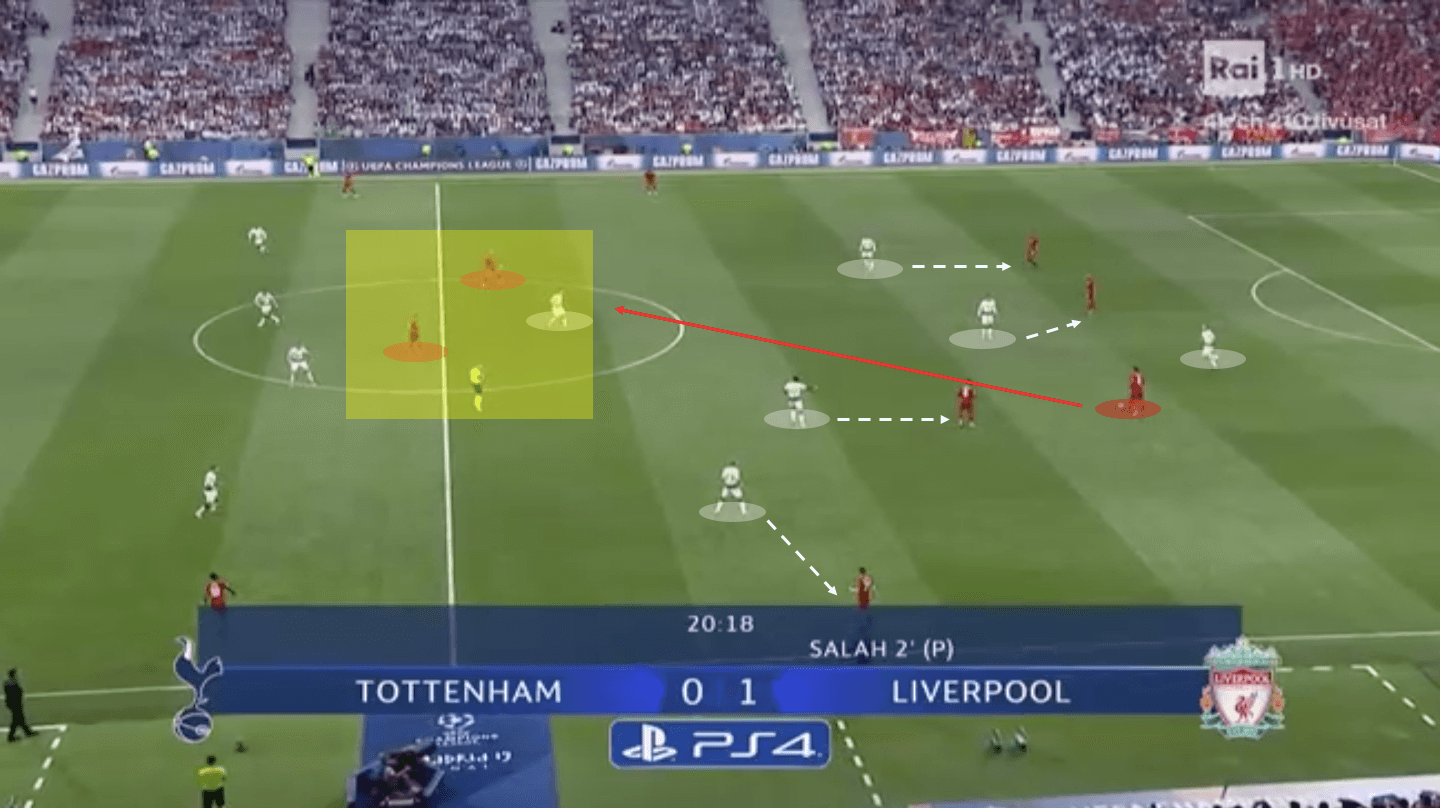
Tottenham are a very proficient pressing side and its clear that Liverpool were aware of this. Much like Liverpool invited Tottenham into playing through the middle, Spurs’ will have looked to lure Liverpool into pressing traps. However, Liverpool avoided falling into any kind of trap at all costs by bypassing their own midfield and attempting to keep the ball in Spurs’ half. Tottenham managed to score two quick goals at the Etihad due to winning the ball high up the pitch and in a game of such importance Liverpool weren’t willing to take this risk.
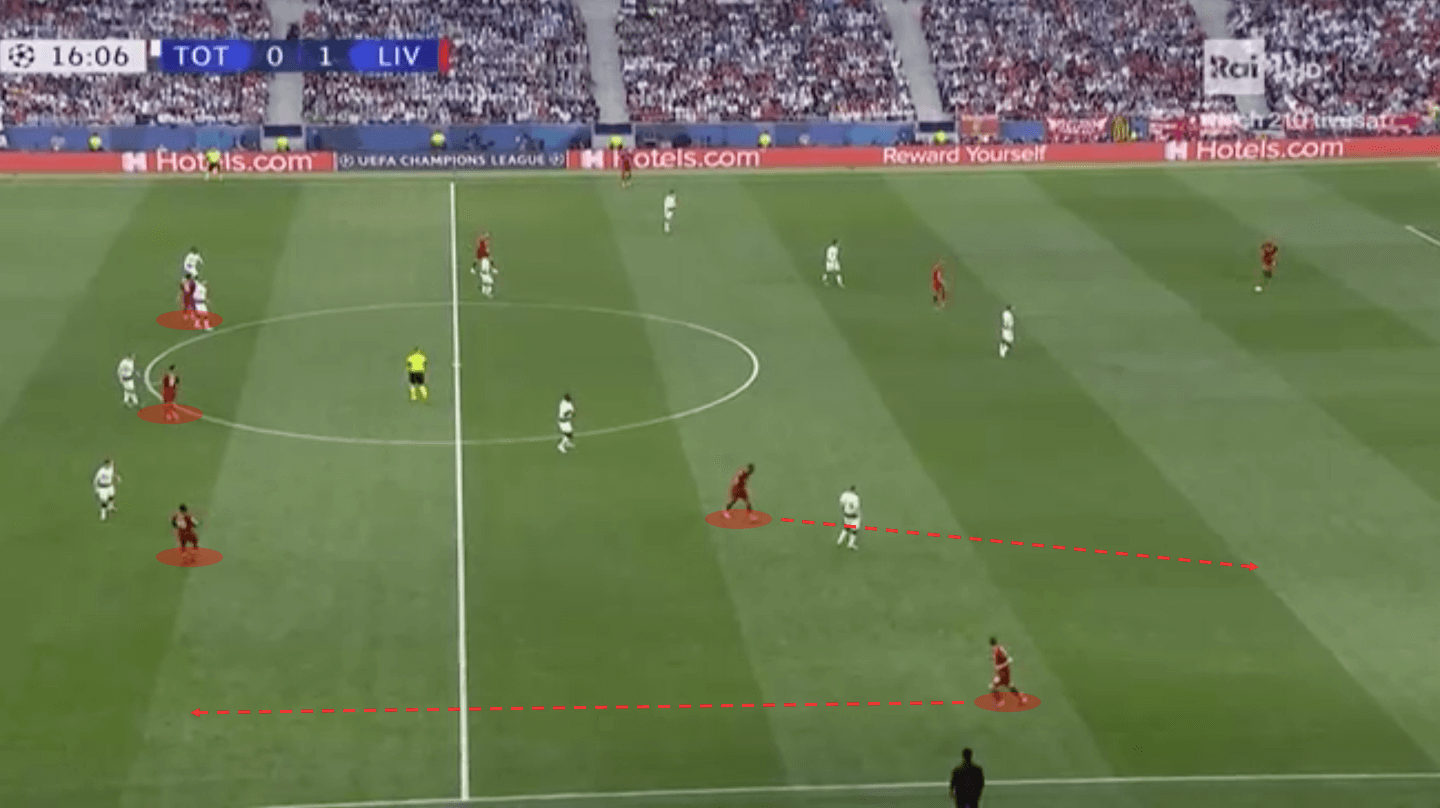
The narrow attacking trio that Liverpool operate with gives them a greater chance at securing possession from long direct passes. In the image above we can see the closeness of the front three. Another common aspect of Liverpool’s style of play which was on show in Marid is the rotations between midfielders and full-backs. We can see that Wijnaldum is dropping into the left-back position which facilitates the movement of Andy Robertson. Robertson is one of Liverpool’s best attacking outlets and enabling him to affect the game in the attacking third of the pitch is often key to victory for Liverpool.
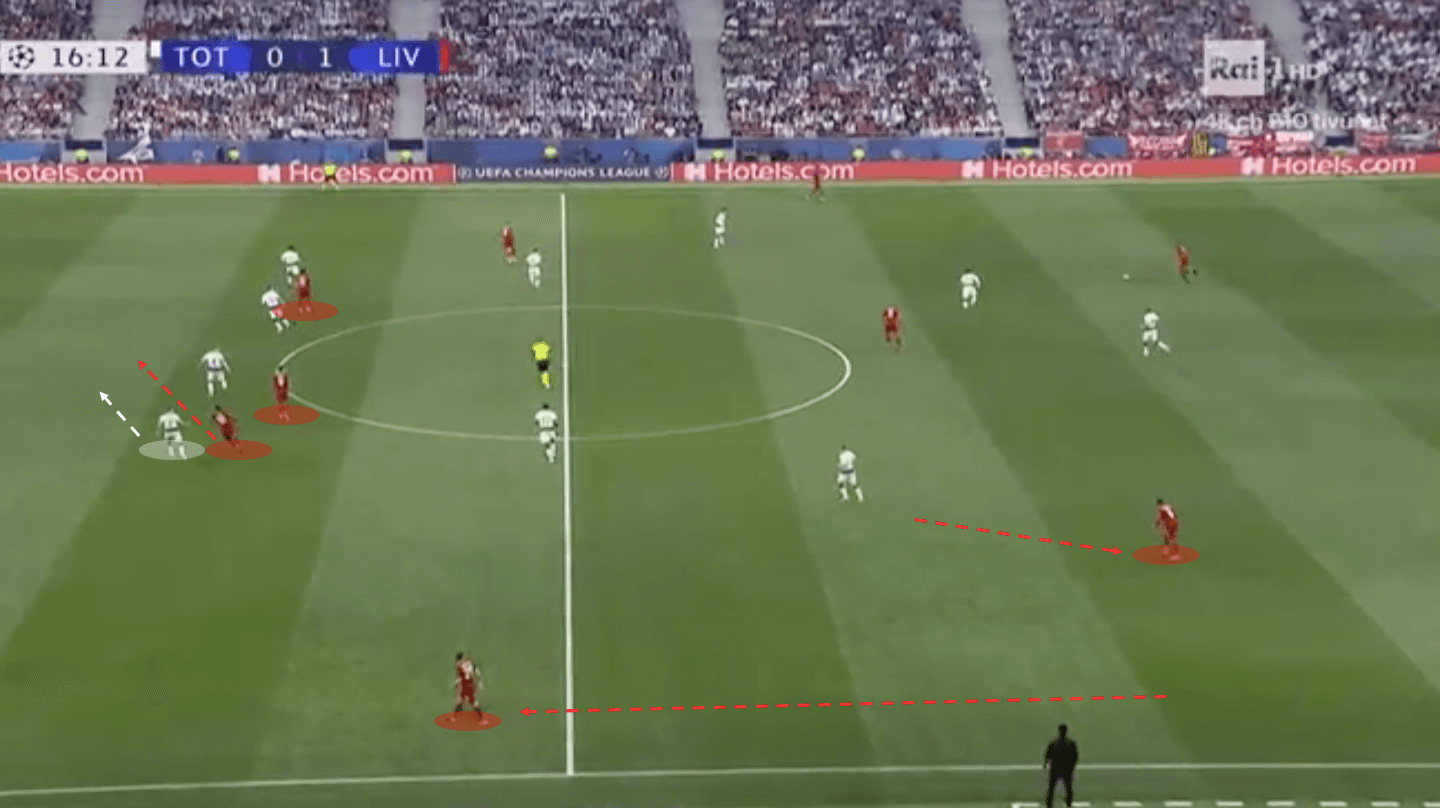
As Matip moves forward with the ball, Robertson is wide open on the left-hand side. However, the gameplan from Liverpool is clear as Mané makes an out-to-in run into space behind the centre-backs looking to latch onto Matip’s long ball.
The nail in the coffin
1-0 down after 86 minutes, this Spurs side would have still felt they could draw level in this game. However, the nail in the coffin was confirmed when Divock Origi lashed home the second goal in front of the Liverpool supporters. The goal came from a half clearance which seemingly bounced around before randomly finding the feet of Origi who was free in the box. But, this is now the third time in three games that Tottenham have conceded a goal against Liverpool from the second ball at a set-piece.
In Liverpool’s 2-1 victory at Wembley early in the season, Wijnaldum scored following a deflected clearance. He was unmarked at the back post much like Origi. The own goal scored by Vertonghen at Anfield came as a result of Tottenham failing to deal with a second ball into the box following a set-piece as Salah ghosted in at the back post unmarked to head the ball down and off Vertonghen.
A combination of the defensive issues in these previous goals was on show here.
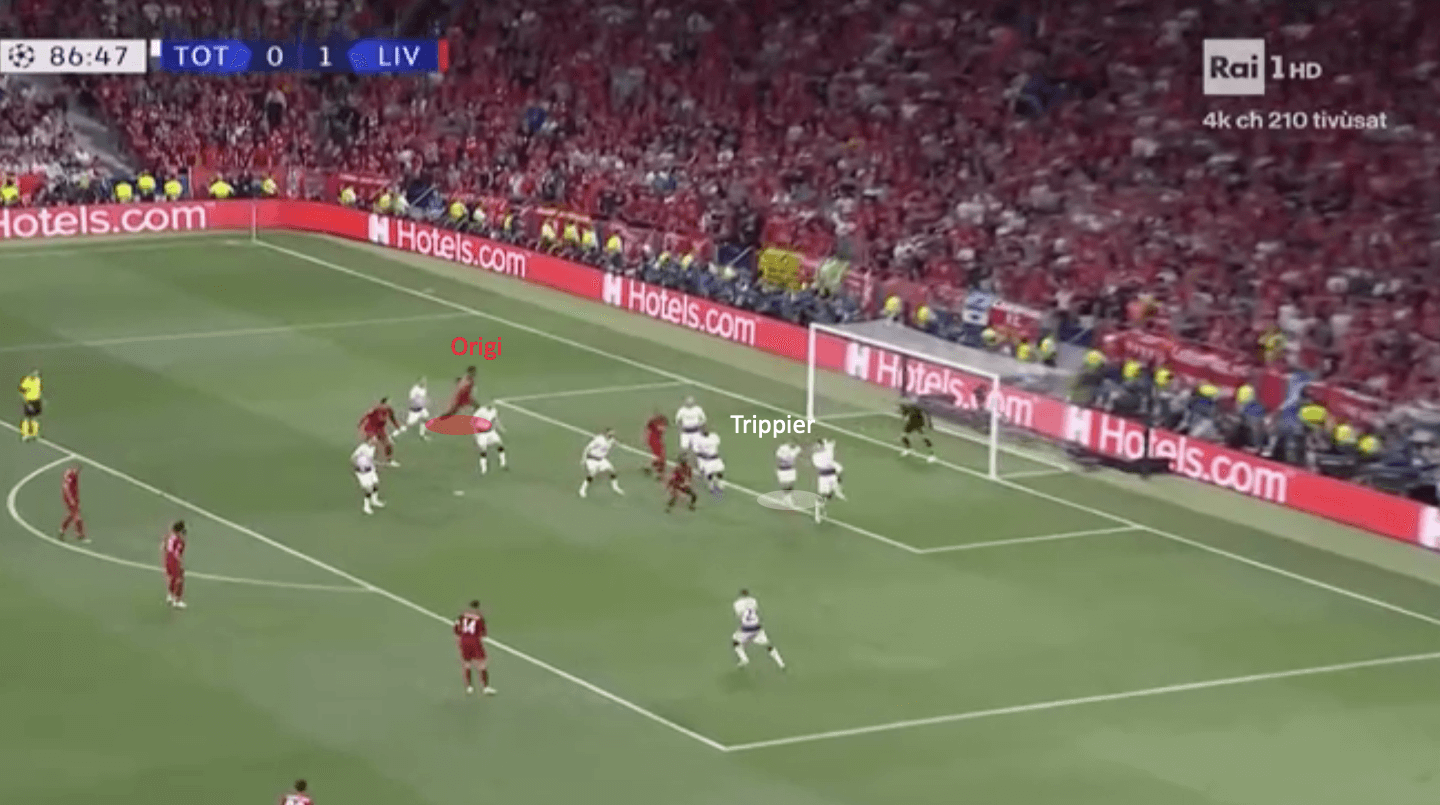
The initial corner is a poor one from Liverpool and is flicked on/away by Son. Divock Origi made a run around the back of the Spurs’ defence to attack the back post. He is unmarked. I have highlighted the positioning of Trippier as his positioning from the corner could become relevant and play into the decision making of the Spurs defenders when the ball comes back their way.
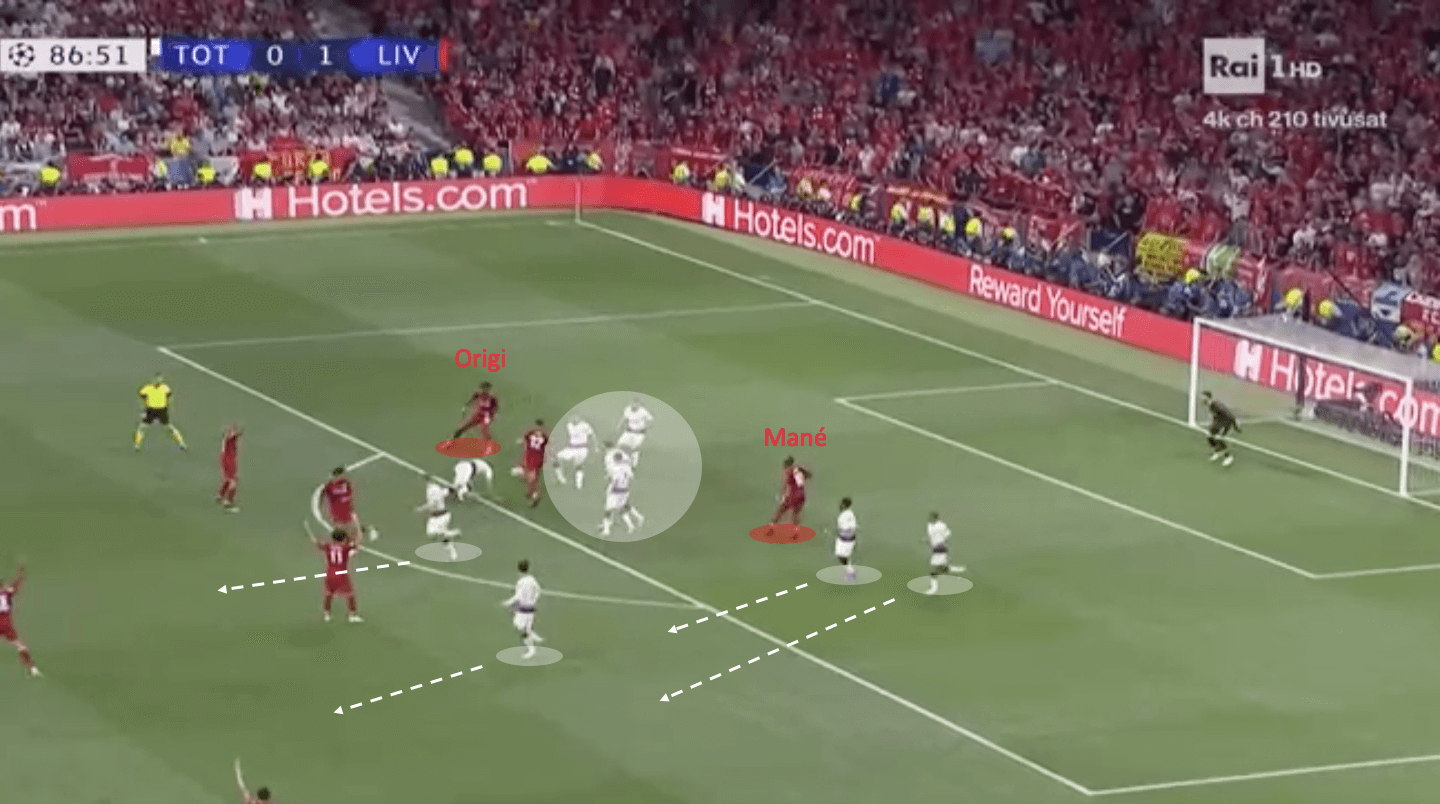
Following the half-clearance, a number of the Spurs players begin to move out of the box. This is intended to play a number of Liverpool attackers offside. However, at least four Spurs’ players have left the box and are thinking about a counter attack. Understandably, they were 1-0 down in the Champions League Final and needed to score but the ease with which Mané becomes free in the middle of the box highlights the disorganisation in the Tottenham defence when dealing with second balls. The four Tottenham players who are still inside the box and aren’t making a dash upfield are clustered together in a very small amount of space. To their right is Origi who has got himself onside and remains unmarked.
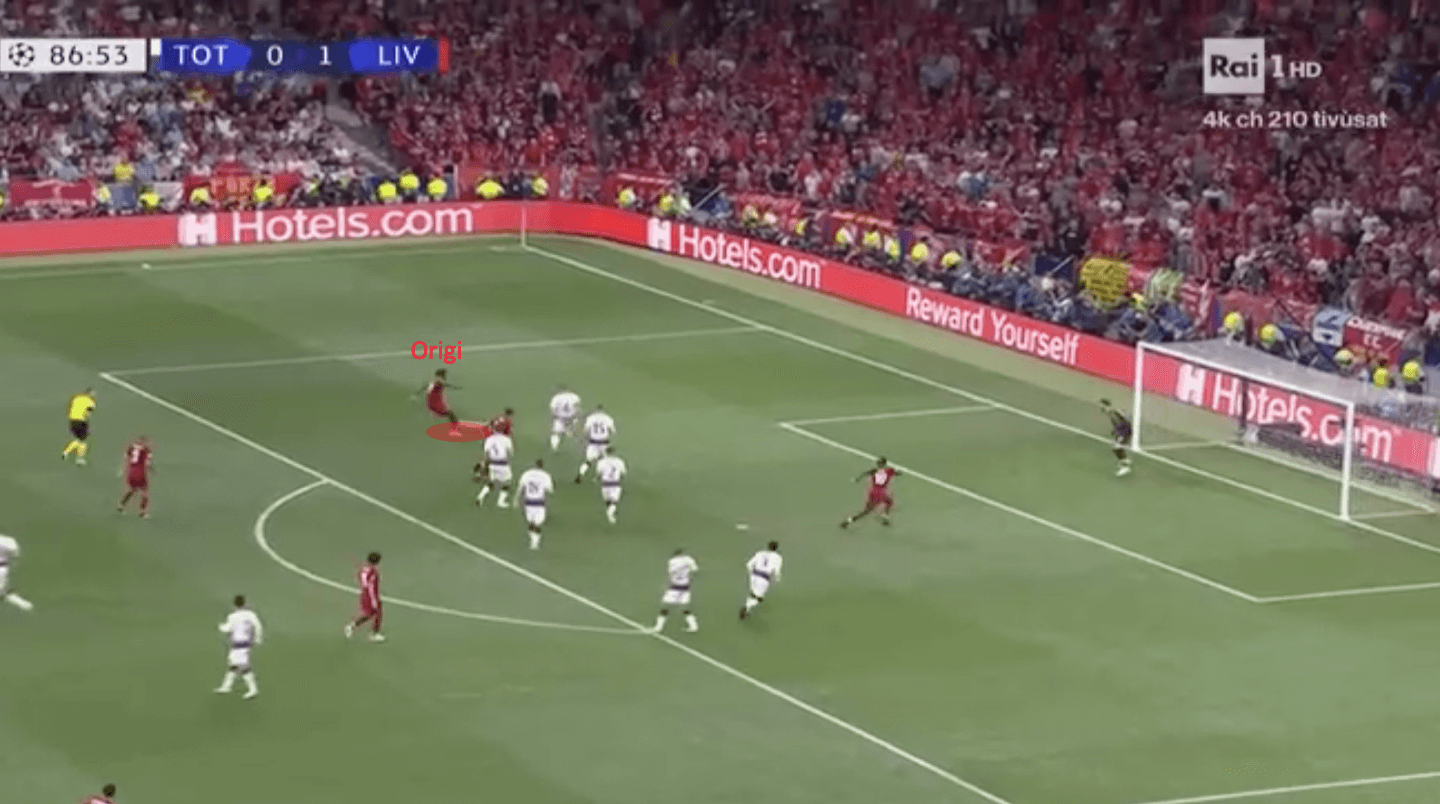
Matip calmly lays the ball into Origi’s path who finishes with aplomb. This is a classy finish and at times you have to hold your hands up, but conceding three goals from similar situations every time they’ve played Liverpool this season will anger Pochettino.
Final thoughts
Whilst many were disappointed that the Champions League Final wasn’t the high-scoring end-to-end spectacle that some neutrals may have hoped for, from a tactical point of view this one was fascinating. With both sides incredibly familiar with each other due to their many meetings domestically, both were wary of falling into the traps the other side was laying for them and as such slightly modified their playing style.
Pochettino and Tottenham can hold their heads high following that performance. On the balance of play, it could be argued that for 80% of the final, Tottenham were on top and if they could have found the final pass who knows what could have happened.
For Klopp and Liverpool, on the other hand, it is hard to argue against them given the majority of their performances in the knockout stages of the competition. Given how impressive Liverpool have been all season it is almost ironic that their worst performance of the season brought them their biggest prize. Whether it was a bad performance or just different in the end didn’t matter given the result. However, one thing that can’t be argued is that Klopp and Liverpool seem to have certain expertise for winning knockout matches and they will certainly be back, looking to defend their crown.
If you love tactical analysis, then you’ll love the digital magazines from totalfootballanalysis.com – a guaranteed 100+ pages of pure tactical analysis covering topics from the Premier League, Serie A, La Liga, Bundesliga and many, many more. Buy your copy of the May issue for just ₤4.99 here, or even better sign up for a ₤50 annual membership (12 monthly issues plus the annual review) right here.

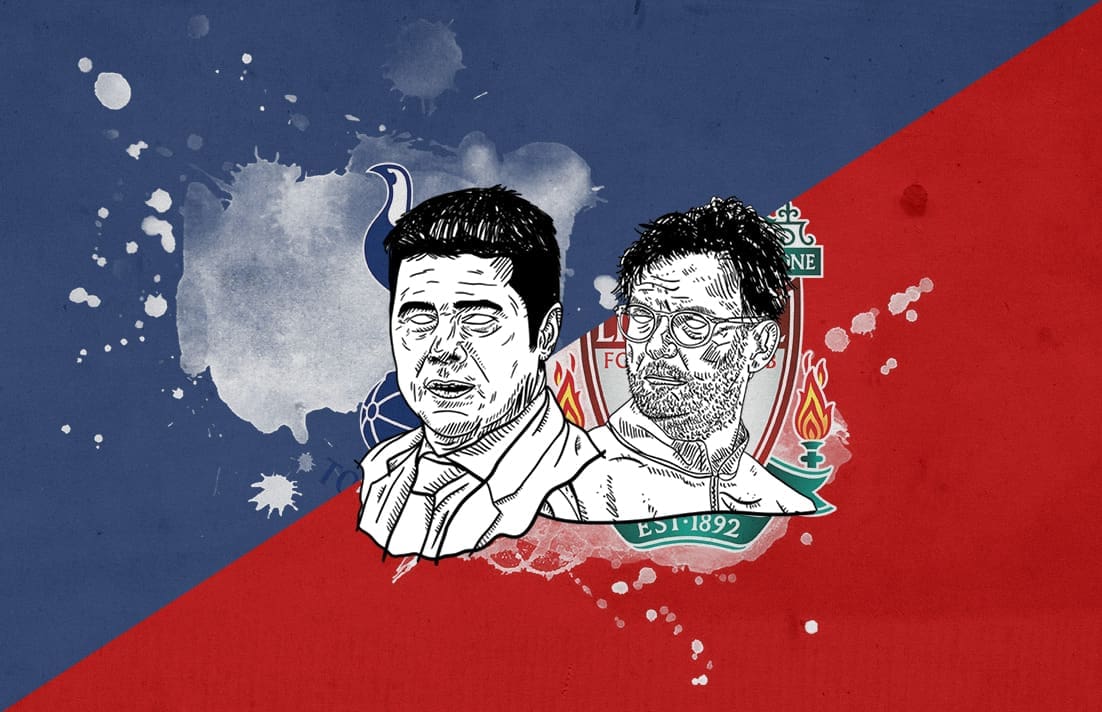



Comments